——— P ———
P – (1) The symbol for power. (2) The symbol for pressure.
P12 – see phantom power.
P24 – see phantom power.
P48 – see phantom power.
PA – Public Address.
Pa – abbreviation for pascal.
PAC – Perceptual Audio Coder.
PACE Anti-Piracy Inc. – a company based in Silicon Valley, California, and founded in 1985, that provides software copy protection and license management services. It is probably best known for its iLok device.
Pacific Microsonics Inc. (PMI) – a developer of software and digital technology headquartered in Union City, CA. PMI developed the HDCD before it was acquired by Microsoft in the year 2000.
packed PCM – see Meridian lossless packing.
packet – a unit of digital data that is transmitted over a network or the internet. Data transmitted in packets are broken up into smaller “chunks” that are a more efficient size for transmission. Each packets is individually identified with a number and the destination address. The various packets of a given file may travel different routes through the network. Upon arrival, they are reassembled into the original file.
pad – (1) An attenuator used to reduce the level of a signal. (2) To reduce the level of a signal. (3) One of the surfaces on drum pads. (4) See pads.
pads – (1) A sustained chord or tone often with the notes stretching over more than one octave, usually generated by a synthesizer, typically used as background harmony and/or atmosphere in a musical arrangement, such as a string pad. Also called spread voicing. (2) Short for drum pads.
pairing – the process through with two devices communicate using a wireless Bluetooth connection. The two devices establish a secure connection by sharing a link key that is stored by each device. Sometimes called bonding.
PAG – Potential Acoustic Gain.
PAL – Phase Alternating Line. The analog television color encoding system used for broadcast television systems in Europe and many other countries. Many of these countries have adopted Digital Video Broadcasting-Terrestrial (DVB-T) as they switch to digital television.
palming – a playing technique in which the side of the picking hand or the edge of the palm is placed over the strings close to the bridge of a stringed instrument to mute the strings or to reduce the sustain. Also called palm muting or simply muting. See also fret-hand muting.
palm muting – see palming.
PAM – Pulse Amplitude Modulation.
PAMA – Professional Audio Manufacturers Alliance.
pan – (1) A control found on mixers, consoles, and DAWs used to adjust the position between the left and right sides of a stereo image. (2) The position between the left and right sides of a stereo image. (3) To adjust the position between the left and right sides of a stereo image. Short for panoramic.
PAN – Personal Area Network. See piconet.
Panasonic Corporation – Panasonikku Kabushiki-kaisha. A multinational electronics company headquartered in Kadoma, Osaka, Japan, formerly known as Matsushita Electric Industrial Co., Ltd. The company was founded in 1918 by Konosuke Matsushita, and has grown to become one of the largest Japanese electronics firms.
pancake – slang for magnetic recording tape wound on a hub with no reel flanges. Tape sold in this fashion is less expensive than that sold on actual reels. Before using a the user must spool the tape onto other reels.
pan control – see panoramic potentiometer.
pan depth – the amount of attenuation applied to a track when it is panned dead center in order to make the level sound the same as it would be if the track were panned hard left or hard right. Various DAWs use different pan depths, and in some DAWs, the pan depth can be adjusted between 1 and 6 dB. See pan law

panel absorber – a framed absorber consisting of a surface in front of a space of 2 to 6 inches in depth, designed to be hung on the wall to absorb low frequencies. If the front surface is made of a material such as plywood, it is called a diaphragmatic absorber. If the frame is covered by a thin material such as plastic, it is called a membrane absorber. If the surface has holes in it, like pegboard, it is a perforated panel absorber, but these panels do not appear to work as well as a diaphragmatic absorbers. Because the front panel sometimes acts as a reflector, the front is sometimes curved or angled. The frequency absorbed depends on the thickness of the panel. Using 4 x 8-foot plywood on a 2 x 4 frame (3.5" deep), the absorption peak for ⅛" plywood is 150 Hz, for ¼" plywood is 110 Hz, and for ⅜" plywood is 87 Hz. Formulas are available for calculating the frequency. The inside cavities are sometimes filled with sound-absorbant material, such as fiberglass or mineral wool, but they must have at least ¼ inch of air to be effective. Filling cavity tends to lower the frequency and increase the amount of absorption. Also called a pressure absorber because it acts on sound pressure. See also porous absorber, resonant absorber, and acoustic treatment.
panic button – a MIDI control that simultaneously sends All Notes Off and Reset All Controllers commands to a MIDI system.
pan law – a principle that states that when any two audio signals of equal amplitude and phase are summed together into a monophonic signal, the loudness will increase by 6.02 dB(SPL). However, in a room the acoustic summing of the same signal from two stereo loudspeakers is typically only 3 dB, because the speaker response and room acoustics are far from ideal. So the perceived loudness as a mono signal is panned from center to hard left or right will change from -3 dB to 0 dB. To compensate for this difference, it is necessary to adjust the pan depth, the amount of attenuation applied when the signal is panned dead center. For a mono signal the attenuation would be 6 dB, but for a stereo signal it would be 3 dB. Some DAWs compromise and use 4.5 dB, but others allow the user to choose the pan depth. Also called pan rule.
panning – the process of adjusting or positioning an audio signal between the left and right sides of a stereo image. There are two types of panning: (a) static panning in which the microphone and sound source remain stationary and panning is adjusted using a panpot and (b) dynamic panning in which either the microphone or the sound source moves across the sound stage, usually as a special effect.
panoramic – see pan.
panoramic potentiometer – the control that divides (pans) the audio signal between two channels, typically the left and right channels of a stereo signal, to position the sonic image. Also called pan control or panpot (sometimes spelled pan pot) for short.
panpot – short for panoramic potentiometer.
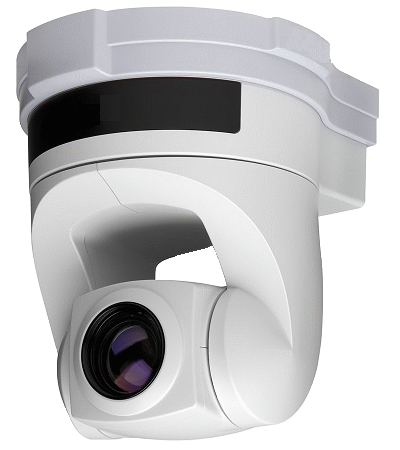
panpot stereo – a recording using multiple microphones, one for each voice, instrument, or group of instruments, each recorded to a separate track, with each track panned left and right in varying amounts, to produce directional information based on intensity stereo. This process is an alternative to true stereo. The recording is mixed down to two stereo channels.
pan rule – see pan law.
pan-tilt-zoom (PTZ) camera – a camera that can be remotely controlled to zoom and to move directionally (pan and tilt). PTZ video cameras are used in television production, especially for sporting events using remote integration. Also called a robo (robotic camera).
papery – a descriptive term for kick drum sound with a boost between 300 and 900 Hz.

PAR – Parabolic Aluminized Reflector. A type of electric lamp used for stage lights and other applications. PAR lamps are designated by their diameter size in ⅛‑inch increments. Common sizes include the PAR38 (4¾‑inch diameter), PAR56 (7‑inch diameter), and the PAR64 (8‑inch diameter).
parabolic reflector – a dish-shaped structure used to focus energy to or from a receiving or transmitting device. Examples include a satellite receiving dish for television and a parabolic microphone. A parabolic microphone consists of a parabolic reflector facing the sound source and a microphone facing the other direction pointing at the center of the parabola. These microphones are used for such applications as capturing the sound at sporting events and for wildlife recordings.
parabolic microphone – see parabolic reflector.
paragraphic equalizer – an equalizer that is a combination graphic equalizer and parametric equalizer. It has sliders like a graphic equalizer and adjustable frequency ranges and Q like a parametric equalizer. Although hardware paragraphic equalizer tend to be large and expensive, software-based systems are priced similar to other EQ plug-ins.
parallel – (1) Two or more processes, functions, or operations taking place simultaneously. (2) Two signals being fed to or through one or more components at the same time. Opposite of series, in which the signals are sent sequentially. (3) A method of sending data in which each digit of a digital word is sent at the same time over separate wires. (4) In music, a sequence of notes that are harmonized by equal-sized intervals, such as parallel thirds or parallel fifths.
parallel chords – see parallel harmony.
parallel compression – a method which blends an uncompressed track with a compressed version of the same track. Typically the wet track is very highly compressed. This technique preserves the transients of the original signal while increasing the level of softer portions of the signal. Parallel compression allows you to increase the overall level of the track without sounding overly compressed. Sometimes called New York Compression or New York City compression, although producer/engineer Bobby Owsinski, who coined the term, says NYC compression is parallel compression only on the drum and bass tracks, along with about a 3-dB boost of a low shelf (less than 100 Hz) and high shelf (above 10 kHz).

parallel harmony – a sequence of musical notes in which each note of harmony has the same interval. Parallel harmony can be viewed as a series of chords having the same intervals. Also known as parallel chords, harmonic parallelism, harmonic planing, or parallel voice leading.
parallel port – a port found on older computers that sends or receives several bits of data simultaneously by using several wires, that is used for connecting external devices such as printers or a scanners. Sometimes called a Centronics interface, since the original parallel port standard was designed by Centronics.
parallel powering – see A-B powering.
parallel processing – a method which blends a processed (wet) track with a unprocessed (dry) version of the same track. Most commonly used with compression. See parallel compression.
parallel voice leading – see parallel harmony.
parameter – any variable that defines a system and controls it performance.

parametric equalizer – an equalizer with which one can adjust various parameters, such as frequency, bandwidth, and gain. Also called a peaking equalizer or a peak-and-dip equalizer, because it has one or more bandpass filters See also graphic equalizer and semi-parametric equalizer.
paraphonic – a term that describes a synthesizer that can produce multiple notes or voices, but is not truly polyphonic because the voices share at least one common element. For example, multiple oscillators generating different notes, but being routed through the same filter and amplifier.
PARC – Palo Alto Research Center, Inc. A company located in Palo Alto, California, that provides research and development for information technology and hardware systems. It was founded in 1970 as a subsidiary of the Xerox Corporation, as the Xerox Palo Alto Research Center. It was instrumental in developing laser printing, the Ethernet, and many other computer applications. It became a wholly-owned subsidiary ox Xerox in 2002.
parity check – a process used in digital recording in which one or more bits of data derived from the audio sample is appended as a part of the 16-bit word and used for error detection. The circuitry determines whether the audio bits are correct and whether the data should be sent on for D/A conversion, discarded, or repaired. Also called a parity code.
parity code – see parity check.
Parlophone – a record label founded in Germany in 1896 by the Carl Lindström Company as Parlophon. Its UK subsidiary was formed in 1923 as The Parlophone Co. Ltd., which was acquired by Columbia Graphophone Company in 1926. In 1931, Columbia Graphophone merged with the Gramophone Company forming Electric & Musical Industries Limited (EMI). Parlophone then operated as a division of EMI until 1965 when it was merged into The Gramophone Co. Ltd., which was was renamed EMI Records Limited. In 2012, EMI was acquired by Universal Music Group, but EMI Records Ltd., which included the Parlophone label, had to be divested. It was operated as the Parlophone Label Group until Warner Music Group (WMG) acquired the group in 2013. EMI Records Ltd. then was renamed as Parlophone Records Limited.
Part 15 – Code of Federal Regulations, Title 47, Part 15 (47 CFR 15). Part of the Federal Communications Commission (FCC) rules and regulations pertaining to unlicensed transmissions. It regulates issues, such as spurious emissions and unlicensed low-power broadcasting. Unlicensed broadcasting on the AM radio band is limited to 100 milliwatts of DC input power to the final RF stage, along with restrictions on size, height, and type of antenna. However, if the AM transmission originates on the campus of an educational institution, there are no power restrictions as long as the signal strength is below a designated level at the edge of campus. Unlicensed broadcasts on the FM radio band are limited to a signal strength of 250 μV/m at a distance of 3 meters from the antenna. Other rules apply to wireless microphones and other wireless devices.
particle displacement (σ) – the measure of the distance a particle is moved from its equilibrium position in a medium as it transmits a sound wave, measured in meters (m). Usually it refers to a longitudinal wave of pressure, such as sound. However, it can also refer to a transverse wave, such as the vibration of a string. In air a particle is displaced in relation to the particle velocity of the sound wave traveling through the air, while the sound wave moves at the speed of sound, equal to 343 m/s (1125 ft/s) in air at 20 °C. Also called displacement amplitude.
particle dispersion – see dispersion, definition #2.
particle orientation – the arrangement of acicular particles in a magnetic coating. The preferred orientation is for the particles to lie parallel to one another, which improves performance and increases particle density and therefore recording tape output.
particle velocity (p) – the velocity in meters per second (m/s) of a particle of a medium (such as air) caused by sound and not due to other velocities like thermal agitation and wind currents. The velocity can be expressed in various ways, such as instantaneous particle velocity or peak particle velocity. Particle velocity is not the same as the speed of the sound wave as it passes through the medium, and is not the same as the speed of sound. A wave moves relatively fast, while a particle oscillates around its original position and has a relatively small particle velocity. Particle velocity also is not the same as the velocity of individual molecules. Higher frequency sounds tend to be transmitted by particle velocity, while lower frequencies tend to be transmitted by pressure.
particle velocity level – see sound velocity level.
part leading – see voice leading.
part writing – see voice leading.
PASC – Precision Adaptive Sub-band Coding. An audio compression scheme developed by Philips and Sony for use on the digital compact cassette (DCC), which they claimed gave better quality audio than the ATRAC used on the MiniDisc.
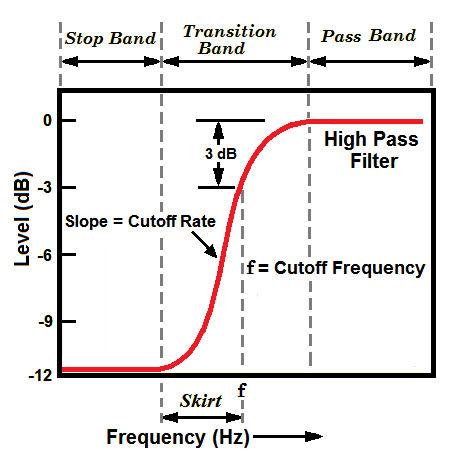
pascal (Pa) – the SI unit for pressure, equal to one newton per square meter (1 N/m2) or one joule per cubic meter (1 J/m3) or one kilogram per meter-second squared (1 kg/(m-s2). Using the US customary units, one pascal equals about 0.000145 pounds per square inch (psi). With the “zero” reference sound pressure in air of 20 μPa (the threshold of human hearing), 1 pascal will equal an SPL of 94 dB. See also sound pressure level.
passband – the frequency range of signals that a filter allows to pass through. The opposite of stopband. Also spelled as the less-preferred pass band.
passband ripple – see ripple.
passing tone – see nonchord tone.
passive – (1) Not using amplifiers or external power sources. (2) Not actively participating; inactive. Opposite of active.
passive circuit – an electronic circuit that contains only passive components, such as resistors, capacitors, or transformers, which require no power, as opposed to an active circuit, which can have both active and passive components.
passive component – (1) A device that does not amplify a signal or increase gain. Examples of passive components include resistors and capacitors. Examples of active components include transistors, vacuum tubes, or integrated circuits. (2) In a computer, things that do not require electrical power to operate, such as the chassis, capacitors, and enclosures. Active components include the power supply, fans, storage devices, transistors, and integrated circuits.
passive crossover – see crossover.
passive driver – a loudspeaker driver that has no voice coil or magnet assembly and is not connected to an electrical circuit, functioning only as a passive radiator. Also known as a drone cone.
passive EQ – short for passive equalizer.
passive equalizer – an equalizer in which the audio signal can only be cut or reduced and not increased or boosted.
passive filter – a type of filter that can only reduce a range of frequencies, unlike an active filter which can boost or cut. Passive filters are usually composed of four basic components: resistors, capacitors, inductors, and transformers, which tends to make them more expensive than active filters. The advantage is they require no external power and they introduce no noise.
passive loudspeaker – a loudspeaker that requires an external power amplifier to drive it and most likely has a passive crossover. Compare with active loudspeaker.
passive monitor – a studio monitor that requires an external power amplifier to drive it and likely has a passive crossover. Compare with active monitor.
passive pickup – an instrument pickup that requires no external power as it has no onboard electronics, such as a preamp.
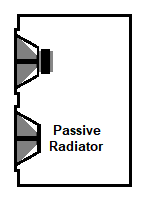
passive radiator – a passive driver in a loudspeaker system that moves due to the internal air pressure in the cabinet created by the movement of the active driver cone. The passive driver is usually the same or similar to the active driver but without a voice coil and magnet assembly. Typically they are used in a bass reflex speaker designs instead of a port, where the extra mass of the passive radiator lowers the resonant frequency allowing smaller cabinet designs. However, they tend to produce a more boomy sound.
passive ribbon microphone – a standard ribbon microphone with no built-in preamplifier, in contract to an active ribbon microphone, which does.
passive speaker – see passive loudspeaker.
paste – (1) To place data in a different place within a document or within another document. The data must first be copied to the clipboard (a temporary storage area in computer memory) by selecting (highlighting) the data you want to copy by choosing “Copy” from the menu, and then pasting it to the desired point. The process is called cut and paste. (2) To place a piece of a digital audio in a different place within a track or within another track, analogous to the cut-and-paste process in definition #1.
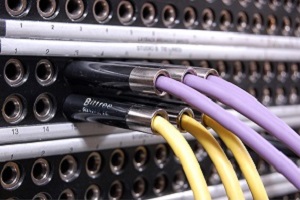
patch – (1) To connect two pieces of audio equipment with a cable. (2) To re-route a signal using a patch cable. (3) A re-routed signal. (4) Short for sound patch. (5) A collection of sampled instrumental parts from a sample library that can be played together.
patchbay – a group of connectors to which inputs and outputs of various devices can be wired to make interconnection between devices easy and accessible. Also called a patch panel or jackfield (British).
patch cable – see patch cord.
patch cord – a short coaxial cable used to route signals in a patch bay or to connect two devices that are separated by a short distance. Sometimes called a patch cable, patch lead, or jumper cable.
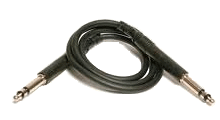
patch editor – a computer program for the creation or modification of sound patches without the use of a synthesizer.
patch in – to insert a hardware processor into an audio signal path. It is the same as to instantiate a plugin.
patch lead – see patch cord.
patch librarian – a computer program that organizes and stores sound patches.
patch panel – see patch bay.
patch point – a connection where a signal can flow from one point to another, such as jack on a patch bay typically using a patch cable. However, it can also be a point within a mixer or other device where the signal can be routed to another point within the device, bypassing one or more circuits in the normal signal path.
patent – (1) The exclusive legal right, given to an originator or an assignee by a government entity for a specified period of time to manufacture, use, or sell an invention. (2) To obtain a patent on an invention.
patent holder – (1) The originator of a patented invention. (2) The employer of the originator of a patented invention under a work for hire arrangement. (3) The person to whom a patent holder transfers in writing the ownership of a patent.
path – (1) The way a signal or current flows through a circuit or device. (2) The line of travel that a sound wave can take. (3) Short for signal path. See signal flow.
path length – the distance between a sound source and a microphone or listener. See also near-field and far-field.
path length difference – the difference in distance between two sound sources and a microphone or listener, or the difference in distance between a sound source and two microphones. It is this difference in path length that determines whether an interference is constructive or destructive for a given frequency of sound..
pattern picking – see fingerpicking.
pause – the button on a tape machine that stops the advance of the tape, but leaves the drive mechanism active to allow for an instant start.
PBG – Parallel-Blade-Ground. See type B plug.
PC – Personal Computer. Originally referred to any microcomputer designed for use by one person at a time. Prior to the advent of the personal computer, computers were very expensive and designed for use by large companies with terminals for multiple users. The term PC has come to mean an “IBM-compatible” personal computer as opposed to an Apple Macintosh computer.
PCB – Printed Circuit Board.
PCC – Phase Coherent Cardioid.
PCI – Peripheral Component Interface or Peripheral Component Interconnect. A high-performance computer expansion slot designed by Intel, that provides a high-bandwidth and processor-independent data path between the CPU and high-speed peripherals. Used in both PC and Macintosh personal computers, they are especially useful for high-data-rate applications like digital audio and video.
PCIe – Peripheral Component Interconnect express. An updated version of the PCI expansion slot that that provides greater bandwidth and higher speeds.
PCM – Pulse Code Modulation.
PCM 1630 – see Sony PCM-1630.
PDC – Plug-in Delay Compensation. See delay compensation.
PDM – Pulse Density Modulation or Pulse Duration Modulation.

peak – (1) The point on a wave where it exhibits the maximum amount of positive or upward displacement from the rest position. The opposite of a trough. Also called a crest. (2) A shape on a curve resembling a the pointed top of a mountain. (3) The maximum excursion from zero of a complete wave cycle. Also called a crest or peak value. (4) An area of a frequency response curve having a an upward deflection from flat.
peak-and-dip equalizer – see parametric equalizer.
peak detecting – responding to the peak values of an audio signal as opposed to responding to average values. Also called peak responding.
peak filter – see bandpass filter.
peak hold – a feature of some level indicators that indicates the peak level and holds that indication for some predetermined period of time, typically one or two seconds.
peak indicating meter – a meter that reads the absolute peak value of an audio signal.
peaking equalizer – see parametric equalizer.
peaking filter – see bandpass filter.
peak level – the measure of a continuously varying parameter, such as voltage, current, or power, from the zero point to the highest point in each cycle. It is equal to half the peak-to-peak value. Also called peak value.
peak meter – a type of meter that visually indicates the instantaneous level of an audio signal. Typically, peak meters consist of a series of LEDs arranged as vertical or horizontal bar, that light up sequentially as the signal increases, often in ranges of green, yellow, and red, to indicate when a signal is starting to clip. See also peak program meter and true peak meter.
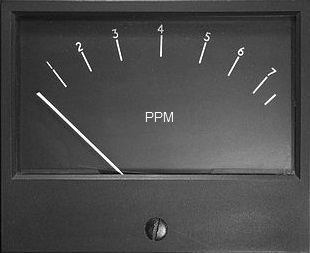
peak normalization – see normalize.
peak program meter (PPM) – an instrument used for indicating the peak level of an audio signal, rather than indicating average audio levels. There are many PPM versions, which fall into three broad categories: (a) true peak program meters, which indicate the peak levels of the waveforms, even those of very short duration, (b) quasi peak program meters (QPPM), which indicate the true peak level only if they exceed a specified duration (usually a few milliseconds), (c) sample peak program meters (SPPM), which indicate peak sample levels for digital audio (but not the true waveform peaks if they fall between samples), and (d) oversampling peak program meters, which are SPPMs in which the signal is first oversampled. The IEC specifies standards for two different PPMs, Type I (developed in Germany) and Type II (developed in the UK). Depending on the broadcast entity, PPMs are usually calibrated in decibels relative to one of the following levels: (a) the alignment level (Nordic, EBU), (b) the permitted maximum level (DIN, ABC, SABC), (c) 0 dBu (CBC), (d) 0 dBFS (IEC), or any combination of the above (BBC). In the US, the VU meter frequently has been used instead of the PPM. The British spelling is Peak Programme Meter.
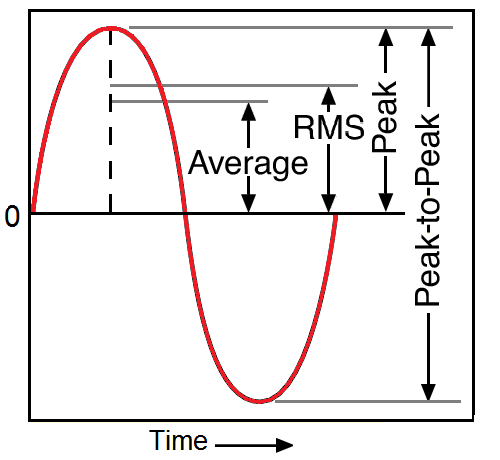
to Peak-to-Peak
peak responding – see peak detecting.
peak response – sensing the amplitude of an audio signal at its maximum value.
peak-to-loudness ratio (PLR) – the difference between the true peak level and the integrated loudness of an audio track or program.
peak-to-peak (P-P) – the measure of a continuously varying parameter, such as voltage, current, or power, from the highest point to the lowest point in each cycle. Compare with peak value and RMS.
peak value – see peak level.
peak voltage – the measure of voltage from the zero point to the highest point in each cycle. It is equal to half the peak-to-peak voltage. Compare with Vrms.
PEAQ – Perceptual Evaluation of Audio Quality. A method for determining the objective measurement of perceived audio quality for perceptual coded digital audio signals, as recommended by ITU-R.
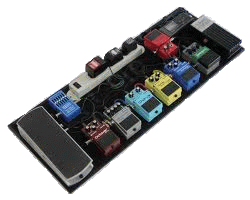
PEC – Protective Earth Conductor.
pedal – (1) A foot-operated lever on a musical instrument that add effects to the signal. Sometimes called a stompbox or effects unit. (2) A foot-operated lever on a piano that controls sustain.
pedal board – (1) A panel on which several guitar pedals are mounted and connected so that a guitar player can use one or more effects at the same time. (2) A widely spaced keyboard played with the feet, such as found on an organ to play bass notes.
pedal steel – short for pedal steel guitar.
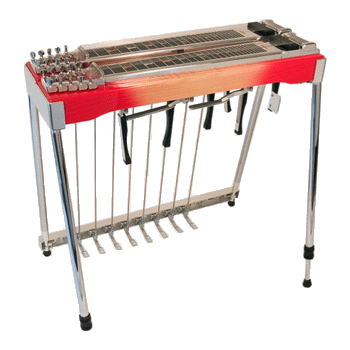
pedal steel guitar – an amplified guitar mounted on a stand and whose pitch can be changed by sliding a steel bar across the strings and by depressing pedals attached to them. Called pedal steel for short.
peg – see tuning peg.
peg head – see headstock.
pel – see pixel.
PEL – Permissible Exposure Limits.
pegging – the situation in which a very high signal causes the needle of a mechanical meter, such as a VU meter, to hit the top of the scale. Besides causing distortion in the audio signal, it can also damage of the meter. Also called pinning.
pencil mic – slang for a microphone, typically a small-diaphragm condenser, with the shape of a long, thin tube, resembling a fat pencil. Sometimes called a lipstick mic or cigar mic..
pencil tool – a tool found in some DAWs that allows free-hand editing of automation, MIDI notes, and other functions.
pen drive – see USB flash drive.
penny whistle – an inexpensive fipple flute, usually having a plastic mouthpiece (fipple) and a thin metal body. Also called a tin whistle, English flageolet, Scottish penny whistle, tin flageolet, or Irish whistle.
Pentatone Records – see Polyhymnia International.
pentatonic scale – a five-note musical scale in which usually the fourth and seventh notes of the diatonic scale are omitted.
pentode – a vacuum tube having five active electrodes. It was invented by Gilles Holst and Bernhard D.H. Tellegen in 1926.
Perceptual Audio Coder (PAC) – an audio codec developed by Bell Laboratories, similar to MP3, that has a flexible format and bitrate. It is used by Sirius XM for its satellite radio service.
perceptual audio coding – see perceptual coding.
perceptual coding – any audio data compression scheme that identifies and removes data that is least likely to be missed by the average human listener, such as audio frequencies that are masked by other, more dominant frequencies, or by temporal masking.
Perceptual Noise Shaping (PNS) – an algorithm that uses perceptual coding to enhance and encode audio compression schemes. See High Efficiency Advanced Audio Encoding (HE-AAC).
percussion – (1) A family of musical instruments that are played by striking with a hand, stick, or beater, or by shaking. Percussion instruments include drums, cymbals, xylophones, triangles, gongs, bells, tambourines, and rattles. (2) The section of a band or orchestra consisting of percussion instruments.
percussive – pertaining or relating to percussion instruments or to the sounds that a percussion instrument makes. In particular, these sounds are often loud and tend to have very sharp transients.
perfect – an interval considered in music theory to be consonant. There are four so-called perfect intervals: perfect unison, perfect fourth, perfect fifth, and perfect octave. The term perfect also applies to intervals for which there are no major nor minor. For example, there is no major and minor fifth.
perfect fifth – the interval between the first note (tonic) and the fifth note of a major scale. The perfect fifth is considered perfect because it is the most consonant interval other than perfect unison and the perfect octave. Most string instruments, such as violins, violas, and cellos, are tuned in perfect fifths.
perfect fourth – the interval between the first note (tonic) and the fourth note of a major scale. The perfect fourth is considered perfect, but it is not as consonant as the perfect fifth.
perfect octave – see octave.
perfect pitch – see absolute pitch.
perfect prime – see perfect unison.
perfect unison – the interval formed by a tone and itself or a duplication of itself. For example, the interval from C to C. Also called unison, prime, or perfect prime.
perforated panel – see panel absorber.
performance rights – rights granted by publishers or performance rights organizations for the public performance of a song. See also mechanical license and master rights.
performance rights organization (PRO) – a group that protects the rights of artists and publishers and collects and distributes royalties to its members. In the US there are three PROs: BMI, ASCAP, and SESAC.
performer – a person who entertains or performs in front of an audience, such as a musician, singer, singer/songwriter, actor, artist, entertainer, dancer, or comedian.
peripheral – a piece of computer hardware that operates separately from the CPU but is connected to it, such as a hard disk drive or printer.
permeability – see magnetic permeability.
permeability constant (μ0) – see magnetic permeability.
performance track – see backing track.
period – the time between one peak of a wave and that of the next. Period is the inverse of frequency. The period (T) can be calculated as T = 1/f, where f is the frequency in Hz.
periphonic – see 3D sound.
periodic – occurring at regular intervals or cycles. Opposite of aperiodic.
permanently-biased microphone – see electret condenser microphone.
permanent magnet – a magnet that retains its magnetic properties, as opposed to an electromagnet that is only magnetic when an electric current is present.
permissible exposure limits (PEL) – OSHA has established legal limits for the permissible exposure limits to many substances including noise. The legal limits for a worker's time average exposure to white noise (A-weighted) over an 8-hour day are a maximum of 8 hours at 90 dBA, 6 hours at 92 dBA, 4 hours at 95 dBA, 3 hours at 97 dBA, 2 hours at 100 dBA, 1.5 hours at 102 dBA, 1 hours at 105 dBA, 0.5 hours at 110 dBA, and 0.25 hours at 115 dBA.
personal area network (PAN) – see piconet.
personal monitor – a device used by musicians and audio engineers for on-stage and recording studio purposes instead of the usual floor monitors. Called PM for short. Also called in-ear monitor (IEM).
perspective – the font-to-back stereo image in an audio signal, controlled by the amount of direct sound and reflected sound mixed into the signal.
PET – (1) Protective Earth Terminal. See protective earth conductor. (2) PolyEthylene Terephthalate. See polyester.
peta- (P) – the SI prefix for a factor of one quintillion, 1,000,000,000,000,000 or (1015).
pF – picofarad.
PFL – Pre-Fade Listen.
phantom – (1) Short for phantom power. (2) Referring to the illusion in which sound seems to be coming from a source other than from where it actually is, as in phantom channel or phantom image.
phantom center – see phantom channel.
phantom channel – the effect in a stereo system when sound seems to come from the center when there is no center speaker. Also called a phantom center.
phantom circuit – a circuit used in telecommunications that uses a pair of wires, one each from two other circuits, to establish a third circuit. It is called a “phantom” circuit because, if the resistance of the wire is equal, conversations carried over the new circuit are hidden from and cannot be heard on the two original circuits (called “side circuits”), and conversations on the side circuits cannot be heard on the phantom circuit. However, if there is unequal resistance in the two wires, crosstalk will occur. Use of a similar circuit to provide power for condenser microphones is why it is called “phantom power.” Also called phantom signaling.
phantom image – a sound source that is perceived as coming from a location where there is no sound source. In a multichannel audio system the sound can seem to come from between any two (or more) of the loudspeakers, and, in some cases, from beyond the loudspeakers. This is similar to a phantom channel in a stereo system. Also called a phantom sound source.
phantom power – a dc voltage supplied by a preamp, mixer, or console through microphone cables to provide power for condenser microphones and other devices. Before the invention of phantom power, each microphone requiring external power had its own power supply usually contained in a small box. Although anywhere from 9 to 48 volts can be used, 48 volts is most commonly used. International standard IEC 61938, defines phantom powering for 48 volts, 24 volts, and 12 volts, designated P48, P24, and P12 respectively, in which the signal conductors are positive and the shield is grounded. The 24-volt version of phantom powering has never been widely used by equipment manufacturers. Phantom powering allows the same two-conductor shielded cables to be used for both dynamic microphones and condenser microphones, without harming balanced microphones that are not designed to use it, as no significant power flows through the output circuit of those microphones. It is called “phantom” because the circuit is similar to phantom circuits originally used by telephone companies.
phantom signaling – see phantom circuit.
phantom sound source – see phantom image.
phase (Φ) – the amount that a wave has passed through its cycle, measured in degrees or radians, with one complete cycle being 360 degrees or 2π radians. Two waves that are exactly aligned in time have a phase difference of zero degrees and are said to be “in phase.” Two waves that are not lined up exactly are said to be “out of phase,” which can cause phase cancellation. Phase is sometimes represented by the Greek letter phi (φ). On some consoles and DAWs, there is a switch labeled “Φ” that is used to reverse the phase of the signal, but in reality it is the polarity that is being reversed. See polarity for further discussion of this difference.
phase angle (θ) – the difference in phase between two waveforms of the same frequency, measured in degrees or radians. Two waves are in phase when the phase angle equals 0° or 0 rad and when the phase angle is 360° or 2π rad. Two waves cancel when the phase angle is 180° or π rad.
phase cancellation – the reduction in wave energy when a wave combines with a wave of the same frequency but somewhat delayed. Two waves that are 180 degree out of phase are in antiphase and will completely cancel one another. Also called destructive interference, bucking, or acoustic phase interference. The opposite of phase reinforcement.
phase coherence – the property of waves having a constant difference in phase over a given time period.
phase-coherent – see time-coherent.
Phase Coherent Cardioid® (PCC®) – the trademark of AKG for its microphone technology that optimizes speech intelligibility in its boundary microphone.
phase compensation – a special equalizer circuit found on some tape machine designed to minimize phase distortion.
phase delay – the amount of time in seconds or milliseconds that an output signal is delayed from the input signal, as opposed to phase shift, which is usually measured in degrees. Also called pure time delay.
phase distortion – a deterioration of a sound when the phase shift in an audio device is not a linear function of frequency. In other words, different frequencies experience different time delays. Also called group delay.
phase distortion synthesis – a method of synthesizing wave shapes to add harmonics using a phase shift.
phase inversion – a term often used incorrectly for polarity inversion or
phase jitter – see intersymbol interference.
phase linear – having the ability to pass or process an audio signal without causing any phase shift.
phase lock – (1) A method of keeping two tape machines in synchronization. (2) The control of one tone generator in a synthesizer to keep it in phase with another tone generator. Also called phase sync.
phase locked loop (PLL) – see phase lock loop.
phase lock loop (PLL) – an electronic circuit with a voltage-controlled or current-controlled oscillator that is constantly adjusted to match in phase (to lock on) the frequency of an input signal. A PLL can be used to stabilize a tranmitter frequency, to generate, modulate, or demodulate a signal, to reduce the noise in a signal, or to multiply or to divide a frequency. Also called a phase locked loop.
phase manipulation – a technique used by some exciters that realigns the relative phase of existing the harmonics in an audio signal.
phase meter – a device for measuring the difference in phase between two signals. Sometimes spelled phasemeter.
phase modulation – the same as phase shift.
phaser – (1) An effects procesor that creates the phasing effect. (2) A hand-held weapon used by Captain Kirk and other crew members on Star Trek that can deliver a variable beam that can stun or destroy.
phase reinforcement – the increase in wave energy when a wave combines with a wave of the same frequency and in or nearly in phase. Also called constructive interference or phase addition. The opposite of phase cancellation.
phase response – the relationship between the phase of an audio signal input and the output signal after passing through a device, such as an amplifier or a filter. A device with good phase response imparts minimal change in phase from input to output.
phase reversal – see phase inversion.
phase shift – (1) The change in the phase of a wave induced by a device or process. Also called phase modulation. (2) The difference in the phase angle between corresponding points on two waves, measured in degrees. The phase shift (φ) is equal to 2 π f t, where π = 3.14, f = frequency (Hz), and t = the delay between the two waves (seconds). (3) Slang for group delay.
phase stereo – see channel coupling.
phase sync – see phase lock.
phasey – a decriptive term for a sound that is out of phase and lacking directional cues. Such a sound can be caused by picking up sound from more than one microphone or with a microphone too close to a flat surface.
phasing – (1) An effect created by combining an audio signal with a version of itself that is passed through several allpass filter stages followed by a modulated short delay resulting in a comb filter effect producing a swishing sound. Phasers typically have two to four stages, but can have as many as 12. The effect is similar to flanging and chorusing. With flanging the signal is not filtered, so that the the phase shift is uniform across the entire spectrum, which results in a comb filter with peaks and troughs that are harmonically related. With phasing, the phase differences depends on the input signal frequency, resulting in peaks and troughs that are not harmonically related. Chorusing uses a longer delay of about 15 to 30 msec, which produces nice tonal variations that simulate a group of singers like a chorus. (2) A hollow, swishing sound created using the phasing effect.
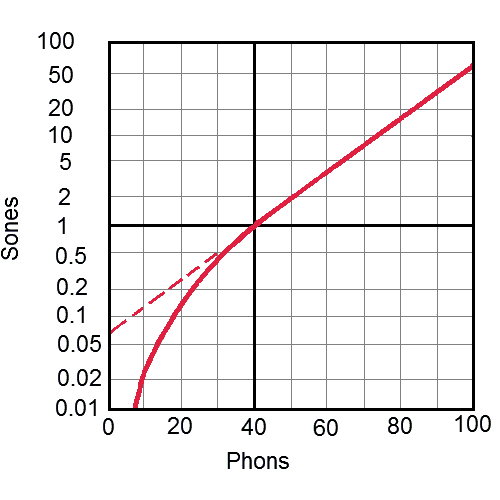
philharmonic orchestra – see orchestra.
philharmonic pitch – See A440.
Philips – Koninklijke Philips N.V. (Royal Philips). A diversified technology company founded in 1891 and headquartered in Amsterdam engaged in the business of consumer electronics and appliances, healthcare, and lighting.
Philips Records – a record company owned by the Dutch electronics company Philips. The record label was found by Philips Phonographische Industrie (PPI) in 1950. Following the separation of the UK Columbia label (owned by EMI) and the US Columbia Records, Philips began distributing Columbia recordings on the Philips label in the UK. When Philips lost its North American distribution deal with Columbia Records in 1961, it signed a distibution agreement with Mercury Records. In 1962, Philips Records and Deutsche Grammophon formed the Grammophon-Philips Group (GPG), becoming PolyGram in 1972. In 1980, Phonogram and Polydor Records merged with PolyGram Records. PolyGram discontinued using Philips as a pop and rock label in the UK and most of Europe, with most new signings going to Mercury in the US and Polydor in the UK and Europe. Philips became a classical music label as a part of PolyGram Classics along with Decca Records and Deutsche Grammophon. In 1983, Philips became the first record label to issue compact discs. In 1998, Philips Records became part of Universal Music Group. In 1999, Philips Classics was absorbed into the Decca Music Group.
phon – a unit for measuring loudness that takes account of the nonlinear response of the human ear. Two sounds with the same dB-SPL, but with different frequencies, will not be perceived as the same loudness. The phon compensates for this difference by comparing the decibel level at various frequencies to that at 1,000 Hz. For example, if a given sound is perceived to be as loud as a 40-dB sound at 1,000 Hz, then it has a loudness of 40 phons. See also sone.
phone connector – see phone plug.
phone jack – the female connector that receives a phone plug. Also called a jack socket (British).

phone plug – a ¼-inch diameter by 1¼-inch long male connector (plug) used for making audio connections. Also available is a 3.5-mm miniature (mini) phone plug and a 2.5-mm subminiature (submini) plug. (The 3.5-mm is often erroneously called a ⅛-inch plug.) They usually come in TS and TRS versions. They are called phone plugs because they were originally used by telephone companies for making switchboard connections. The term phone connector is used to refer to both the phone plug and phone jack. Also called a jack plug (British)
phon lines – see equal loudness curves.
phono cartridge – see phonograph cartridge.
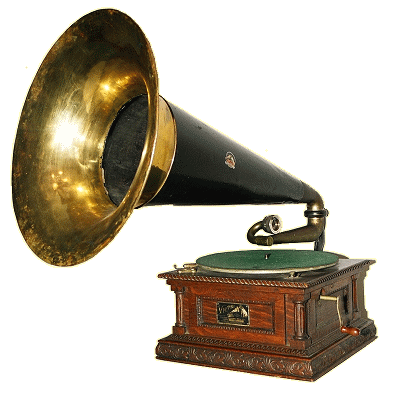
phono connector – see phono plug.
phonograph – a machine that reproduces sound from a record, consisting of a turntable that spins a rotating disc or cylinder (the record) at a constant speed and a stylus that travels along a groove and detects vibrations that are converted into sound, which is amplified and played over a loudspeaker (or in earlier models, an acoustic horn). Originally, the term was used only for cylinder machines while the gramophone was used for machines using discs. However, the term phonograph has come into prominent usage in the US for all record players while the term gramophone became the prominent term in the UK. Also called a record player.
phonograph cartridge – a transducer mounted on the tonearm of a phonograph or turntable that converts the movements of a stylus (needle) moving in the grooves of a record into electrical energy, so that it can be amplified and played through a loudspeaker.

There are several types of cartridges. Crystal cartridges were used in early electronic phonographs, where the movement of the stylus created stress in a piezo-electric crystal, generating an electrical signal. Crystal pickups are fairly sturdy and produce a strong signal, but the output is not very linear resulting in undesirable distortion. The ceramic cartridge, another piezoelectric device, was an improvement over the crystal cartridge using higher quality ceramic materials. They are more sensitive, provide lower distortion, and work at lower tracking forces, which means reduced wear on both the disc and stylus. The magnetic cartridge creates an electrical signal by the stylus moving a piston within a magnetic field. It by far offers the highest fidelity reproduction of the music and lower tracking forces, but it produces a relatively weak signal that must be preamplified before going to the amplifier. There are two common versions of magnetic cartridges: the dynamic cartridge, later called a moving coil (MC), and the moving magnet (MM). While they both operate on the same principle, the moving magnet type was far more common and more robust, but many audiophiles claimed that the moving coil system produced higher fidelity sound. Also called a phonograph pickup, gramophone pickup, gramophone cartridge, phono cartridge, or simply cartridge.

Panel Mount (L)
Cable Mount (R)
phonograph cylinder – see wax cylinder.
phonogram – a sound recording. See also phonorecord.
phonograph horn – see acoustic horn.
phonograph pickup – see phonograph cartridge.
phonograph record – see record.
phono input – a stereo input that feeds the phono preamplifier portion of an amplifier. If it is marked MC, it means that it is designed to handle the characteristics (input impedance, gain, and de-emphasis equalization) of a moving coil (MC) phono cartridge. The output impedance of a moving coil cartridge is in the 10 to 100 ohm range and requires a special matching transformer. If it is unmarked or marked MM, it means it is designed for use by a moving magnet (MM) cartridge. Sometimes called an RIAA input.
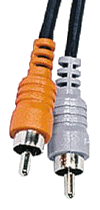
phono jack – the female connector that receives a phono plug. Also called an RCA jack, pin jack, or Cinch jack.
phono plug – a male connector (plug) used with coaxial cable, consisting of a center pin surrounded by a ring of pressure-fit tabs for the shield or ground. The term phono connector is used to refer to both the phono plug and phono jack. Sometimes called an RCA plug because RCA introduced the plug in the 1940s to connect the phonograph to the pickup. Also called a Cinch plug or pin plug.
phonorecord – a legal term defined by the United States Copyright Act as a material object in which sounds (except those on a motion picture or other audiovisual work) are recorded and from which the sounds can be reproduced, either directly or with the aid of a machine or device. It differs from a sound recording (also called a phonogram), which is audio that has been stored in an analog or digital format, whereas a phonorecord is the physical medium on which that sound recording is stored. Examples of phonorecords include wire recordings, phonograph records (vinyl discs), reel-to-reel tapes, 4- and 8-track tapes, compact cassettes, compact discs, audio DVDs, and digital audio files, such as MP3s, that are stored on computers, compact discs, or USB flash drives.
photocell – see photoresistor.
photocell tremolo – see optical tremolo.
photocoupler – see opto-isolator.
photodetector – see photosensor.
photoresistive opto-isolator – see resistive opto-isolator.
photoresistor – a light-controlled variable resistor, in which the resistance of the resistor decreases as the light intensity increases. A photoresistor is made of a high-resistance semiconductor. They are used in some audio compressors in which they are used with an incandescent light, neon lamp, or light-emitting diode for gain reduction. They are also used in many guitar amplifiers for an onboard tremolo effect, where an oscillating light pattern controls the level of signal running through the amp circuit. Also called a light-dependent resistor (LDR) or photocell.
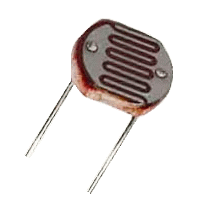
photosensor – an electronic detector that converts light or other forms of electromagnetic energy into an electronic signal that varies with the intensity or distance of the light source. A photosensor consists of a housing, photocell, optics, and electronics. Also called a photodetector or optical sensor.
photon – a particle representing a quantum of light or other electromagnetic radiation. A photon has energy proportional to its frequency, but has no rest mass. It is represented by the Greek letter gamma (γ).
Phrygian mode – one of the seven musical modes or scales with the interval pattern of semitone-tone-tone-tone-semitone-tone-tone.
physical address – see MAC address.
physical media – physical materials (objects that can be touched and felt) used to store and transmit information, such as audio and video. The term is often used to distinguish it from digital media, a format that can only be read by a computer. Examples include phonograph records, compact discs, and magnetic tapes.
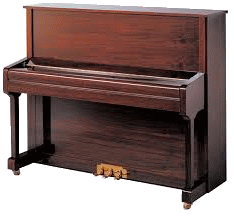
physical modeling synthesis – creation of a sound with a synthesizer using computer programs that mathematically model the physics of a particular musical instrument.
physical network interface – see network interface controller.
pi – see π (pi).
PI – Program Identification or Program Information. See radio data system.
pianist – a musician who plays a piano, especially one who performs expertly or professionally. See also keyboardist.
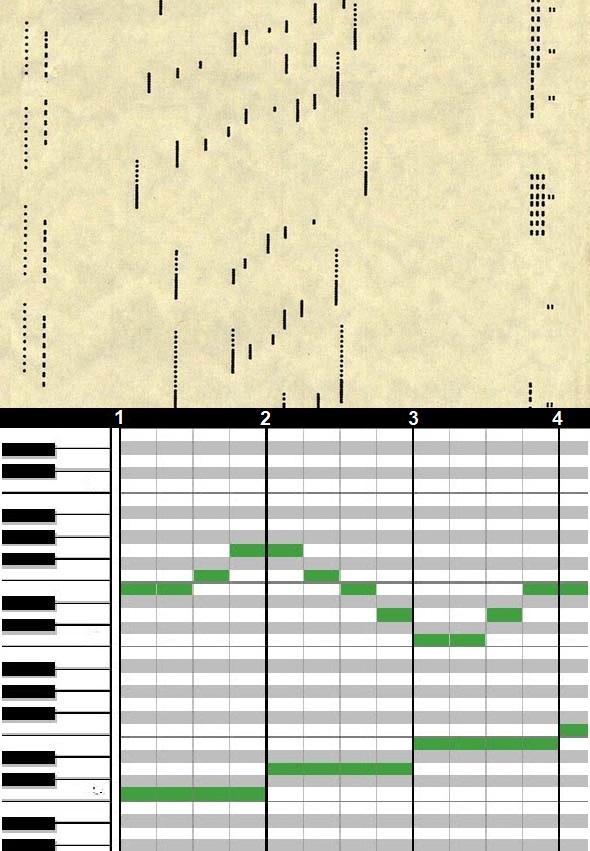
Bottom: Definition #2
piano – (1) A large keyboard musical instrument with a wooden case enclosing a soundboard and metal strings, which are struck by felt-padded hammers when the keys are depressed. The piano was originally called a pianoforte (meaning “soft-loud”) because, unlike the harpsichord which it essentially replaced, it could be played loudly or softly. Pianos have been made in several styles including the grand piano, upright piano, spinet piano, and cabinet grand. There are also electric pianos that reproduce the sound electronically. (2) A musical term meaning to play softly or quietly.
piano accordion – see accordion.
pianola – see player piano.
piano roll – (1) A roll of paper with holes punched into it used to operate a player piano. As the paper rolls over a reading system (called a tracker bar) the holes trigger musical notes causing the piano to play that note. (2) In most DAWs, a graphical display of MIDI note data that provides a means to enter and edit MIDI data, such as pitch, duration, and velocity. The piano roll display is analogous to the player piano roll in definition #1 and provides an alternative method of entering MIDI data instead of manually recording the output of a keyboard.
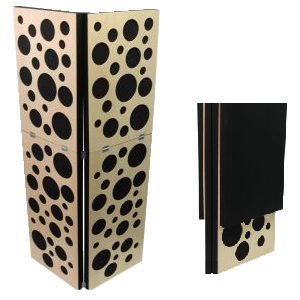
PIB – Portable Isolation Booth. An isolation booth made by GIK Acoustics consisting of two 6.5-foot panels made of 2-inch-thick rigid fiberglass covered with a thin, rigid plate with cutouts to provide absorption while being semi-reflective. It is hinged and collapsible with a folding design that makes it portable. Unfolded it functions like a vocal booth, but when collapsed it can be used as a isolation booth for recording acoustic instruments.

piccolo – a musical instrument in the woodwind family, of similar construction to the concert flute, but about half its size and pitched an octave above it.
pick – (1) A small thin, somewhat triangular-shaped device made of metal, plastic, or ivory usually held between the thumb and index finger and used to pluck a stringed instrument. Also called a flat pick or plectrum. (2) To pluck a stringed instrument.
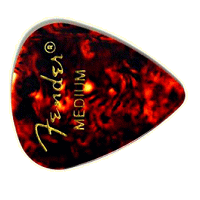
pickguard – a piece of plastic or similar material placed on the body of a guitar, mandolin, or similar plucked string instrument to protect the finish of the instrument from being scratched by the pick. The design of a pickguard can range from fairly plain to very ornate. Also spelled pick guard. Sometimes called a scratch guard or scratchplate.
picking hand – the hand that picks, plucks, or strums the strings of a guitar, mandolin, or similar plucked string instrument. This is usually a person's dominant hand, but many left-handers choose to play right-handed guitars. See fretting hand.
pick harmonic – a guitar playing technique in which the thumb, index finger, or palm of the picking hand slightly catches the string after it is picked, canceling the fundamental frequency, allowing one of the harmonics to dominate, resulting in a sound that squeals on an electric guitar, especially when distorted. By using string bending, a whammy bar, a wah-wah pedal, or other effects, the player can vary the pitch and timbre to achieve a variety of sounds. Also known as pinch harmonic, squelch picking, or squealy.
pick scrape – a guitar playing technique in which the pick is held against one of the wound strings and moved up or down the string. As the pick moves it catches the string windings in rapid succession causing the string to vibrate producing a scratching, grinding, or grating sound. The technique is most effective on electric guitar as it is not loud enough on an acoustic guitar, sounding more like fret noise. It is typically used in the rock, punk or metal music genres. Also called pick slide.
pick slide – see pick scrape.
pickup – (1) A transducer used to convert the vibrations of a string instrument, such as an electric guitar or electric bass, into an electric signal that can be amplified. There are basically two types of pickups, mechanical (piezo) and magnetic. Also called an instrument pickup. (2) The directional sensitivity of a microphone. (3) A transducer used to convert vibrations in a record groove into electric signals. Also called a phonograph cartridge. (4) To receive a signal using a pickup.
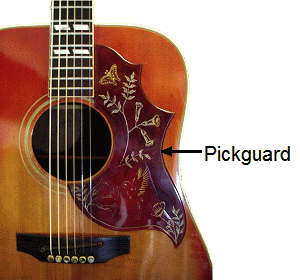
pickup angle – see acceptance angle.
pickup measure – see pickup note.
pick up mode – see catch up mode.
pickup note – one or more notes at the beginning of a piece of music. Normally each measure must contain the number of beats specified in the time signature. The exception to this rule is the first bar, which may contain fewer beats. In this case, the notes are called pickup notes and the first measure is called a pickup measure. The extra beats usually are taken from the final measure.
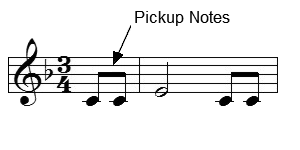
pickup pattern – the shape of the area to which a microphone is equally sensitive. A pickup pattern gives similar but less detailed information than a polar pattern. Sometimes spelled pick up pattern. Also called a response pattern, directional pattern, microphone directivity, microphone directionality, or directivity response.
pico- (p) – the SI prefix for a factor of 10‑12 or one trillionth.
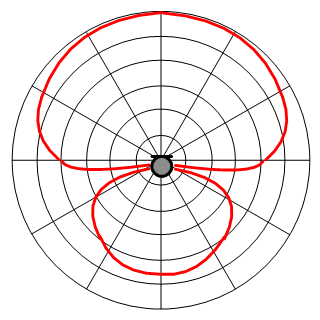
Compare with
Polar Pattern
picofarad (pF) – one trillionth (10‑12) of a farad.
piconet – a network of devices connected on the same Bluetooth channel, that functions like a small wireless network. The network can have from two to eight connected devices. One device takes the role as the master while the other devices become slaves. The name comes from “pico,” meaning small and “net,” short for network, because it is limited in both number of devices and the range, which is about 10 meters (32.8 ft). Data transfer rates vary from 200 to 2,100 kbps. Sometimes called a personal area network (PAN).
picture element – see pixel.
“piece of wire with gain” – see “straight wire with gain.”
piercing – (1) A descriptive term for a strident, shrill sound that is hard on the ears, typically having sharp peaks in the 3 to 10 kHz range. (2) Something that some muscians do in order to hang jewelry from various appendages on their bodies.
piezo – short for piezoelectricity, piezoelectric crystal, piezo pickup, or piezoelectric microphone.
piezo 13-pin system – a MIDI guitar system that uses invidiual piezo elements for each string and sends the signals through a 13-pin cable to a pitch-to-MIDI converter.
piezoelectric ceramic – a ceramic, such as lead zirconate titanate (often called PZT), that produces a voltage when subjected to pressure. Although piezoelectric ceramic is often used interchangeably with piezoelectric crystal, they are technically different.
piezoelectric crystal – a crystal, such as quartz, that produces a voltage across its opposite faces when subjected to pressure. Although piezoelectric crystal is often used interchangeably with piezoelectric ceramic, they are technically different.
piezoelectric effect – see piezoelectricity.
piezoelectricity – the ability of some crystals to produce a voltage when subjected to pressure or stress. Also called the piezoelectric effect.
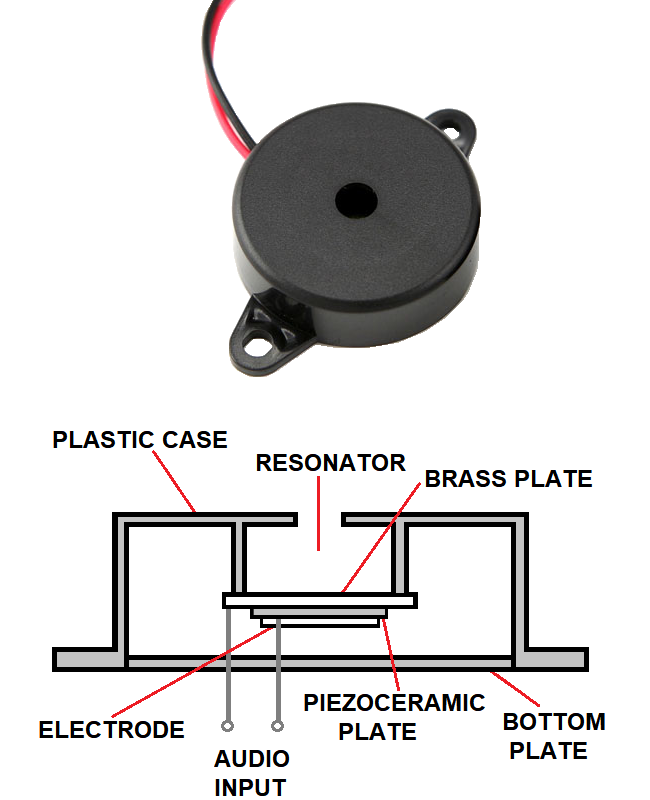
piezoelectric loudspeaker – a loudspeaker that uses a piezoelectric material to generate sound. A voltage is applied to a piezoelectric crystal that is attached to a diaphragm, and the resulting mechanical movement creates sound. The advantages of piezoelectric speakers over conventional loudspeakers are they are resistant to overloads that can destroy other drivers and they can be used without a crossover. The main disadvantage is poor frequency response. Because of that, they are often used only as single-tone buzzers, but they also have been used in electronic devices, such as watches and smart phones or as tweeters in inexpensive speaker systems, such as computer speakers. At least one manufacturer has used them in their digital televisions sets. Sometimes called a piezo speaker and colloquially called a pizo.
piezoelectric microphone – a microphone that uses piezoelectricity to convert sound vibrations into an electrical signal. A crystal microphone is one example of this type of device. Sometimes called piezo microphone.
piezoelectric pickup – a transducer used to convert the vibrations of string instruments, such as electric guitar and electric bass, into an electric signal that can be amplified. Mechanical vibrations cause microscopic distortions in the shape of a piezo-electric crystal, which generates a small voltage. See also magnetic pickup.
piezoelectric tweeter – see tweeter.
piezo loudspeaker – see piezoelectric loudspeaker.
piezo microphone – see piezoelectric microphone.
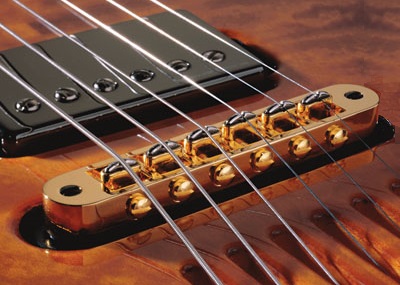
piezo pickup – see piezo pickup.
piezo quack – slang for the harsh sound of a guitar using a piezoelectric pickup that is overdriven or input into a preamp with low impedance (a piezoelectric pickup requires a preamps with an impedance of 10 megohm or more).
piezo speaker – see piezoelectric loudspeaker.
piezo tweeter – see tweeter.
pizo – a colloquial form of piezo.
pigtail – bare wires on the end of an audio cable instead of a connector, used to connect cables to binding posts or screw terminals.
pigment – another name for magnetic coating, a term carried over from the paint and coating industry.
pillarboxing – displaying a video with black bars on the sides of the image to accommodate images of differing aspect ratios, such as a 4 x 3 image displayed on a 16 x 9 screen. Pillarboxing is the vertical equivalent of letterboxing. Sometimes called reverse letterboxing. See also windowboxing.
pilot tone – (1) A 19-kHz tone transmitted with MPX stereo FM broadcasts, used to synchronize the oscillator in the receiver to 38 kHz for the detection of the stereo subcarrier. If not filtered out of the receiver output, it can cause problems with Dolby noise reduction. (2) A 60-Hz sine wave that is recorded on one track of a recording tape when a motion picture film is being shot, used to accurately measure of the camera speed. Later during playback the pilot is used to synchronize the tape playback to the movie action. This allows movie sound and picture to be recorded independently.
PIM – Phase Intermodulation Distortion. PIM occurs in amplifiers when one signal causes phase modulation of another signal.
PIMA – the letters used to indicate fingering of a guitar, from the Spanish words for the fingers of the right hand: pulgar (thumb), indice (index), medio (middle), and anular (ring).
pin 1 problem – a design error in which equipment manufacturers at one time connected cable shields to the common trace of the circuit board which was then connected to the chassis. Cable shields are essentially an extension of the shielding enclosure of equipment, and they only should be connected directly to that shielding enclosure. Connecting to the circuit board introduces the possiblility of noise and interference.
pinched – a descriptive term for a sound with a very narrow frequency range.
pinch harmonic – see pick harmonic.
pinch roller – a wheel on a tape recorder usually made of rubber that presses the recording tape against the capstan so that it can be evenly pulled across the heads and onto the take up reel. Sometimes called an idler roller. See tape machine for diagram.
pin jack – see phono jack.
pinning – see pegging.
pin plug – see phono plug.
ping-pong – to bounce a track in a multitrack recording.
ping-pong delay – a delay in which the effect alternates between the left and right channels, like a ping pong ball bouncing back and forth across the table.
pink noise – a random noise with a a 3-dB decrease in energy per octave. Because every octave contains the same amount of energy, pink noise is often used as a reference signal in audio engineering. See noise colors.
pin out – the configuration (arrangement and function) of the connections on a multi-pin connector. Also spelled as pin-out and pinout. See chart of Standard Audio Connections.
pipeline delay – see conversion latency.
pipe organ – see organ.
pit – a microscopic depression on an optical disc burned into the surface with a laser, used to store digital data. Each pit represents the digit 1, while the space between pits (land) represents the digit 0.
pitch – (1) A property of sound consisting of repeating vibrations at a specific frequency, as opposed to unpitched sound, which is noise. (2) The musical quality of a tone as determined by its frequency. (3) The perception of the frequency of a sound by the human ear. (4) A musical tone or note expressed by a letter from A to G. See chart showing all the pitches and their frequencies, as well as the corresponding MIDI note numbers. (5) To categorize an instrument or voice in a particular musical range. (6) The number of grooves per inch on the surface of a phonograph record.
pitch bend – (1) A smooth change in pitch caused by the movement of a pitch-bend wheel or lever. See also bend depth. (2) The wheel or MIDI command that creates a pitch shift.
pitch bend controller – see pitch wheel.
pitch bend wheel – see pitch wheel.
pitch correction – a process in which the pitch of a note played or sung can be changed to the correct pitch without changing the speed. The process can be used to correct bad notes without being noticed by the listener, or as a special effect that rapidly changes the sound, an effect now known as the “Cher effect.” There are several brands of pitch correction including Antares' Auto-Tune and Celemony's Melodyne. Sometimes called tuning correction or intonation correction.
pitch control – a control on some audio playback devices, such as turntables, CD players, and tape decks, that provides for changing the playback speed, in order to change the the pitch or frequency of the sound, to match a tempo, or to fit within an allotted time. Some devices have the ability to compensate for the change in frequency that occurs with the change in the speed so that no change in pitch occurs. Also called a vari-speed, especially when used on tape decks in the UK.

pitch length – see lay length.
pitch generator – a signal generator. Also called a tone generator.
pitch pipe – a small flute or reed-type instrument that produces one or more tones when blown to establish the pitch for singing or tuning an instrument.
pitch range – see vocal range or voice type.
pitch shifting – raising or lowering the pitch of a sound without changing its duration or timing. A pitch shift can be as little as a fraction of a cent (such as when doubling, widening, or chorusing) or by as an octave or more for creating harmonies or special effects. Compare with frequency shifting. Also called pitch transposing.
pitch shifter – a plugin or processor that raises or lowers the pitch of a sound. See pitch shifting for more details.
pitch standard – See A440.
pitch-to-MIDI-converter – a device that senses the pitch of an analog audio signal and converts it into MIDI note number data.
pitch transposing – see pitch shifting.
pitch wheel – a control in the shape of a wheel or lever found on keyboards of MIDI controllers and synthesizers that smoothly adjusts the pitch of a note up or down. Also called a pitch bend wheel or pitch bend controller. See also modulation wheel.
pixel – a physical point in a raster image or a point in a digital image, the smallest element used to create the image. Short for picture element. Sometimes called a pel.
PL20 – see Electro-Voice RE20.
place theory – a theory of hearing that states that ability of the human ear to distingusih pitches is determined by what area of the tympanic membrane is affected by the sound.
planar loudspeaker – see planar magnetic loudspeaker.
planar headphones – see planar magnetic headphones.
planar magnetic headphones – headphones that operate in a manner that is a hybrid between dynamic headphones and electrostatic headphones. The planar magnetic driver has a relatively large diaphragm, a thin membrane containing an embedded wire pattern that is suspended between two sets of oppositely aligned permanent magnets. When current from an audio signal is passed through the wires in the diaphragm, the magnetic field produced reacts with the field of the permanent magnets and induces movement in the membrane, which produces sound. Also known as othodynamic headphones.
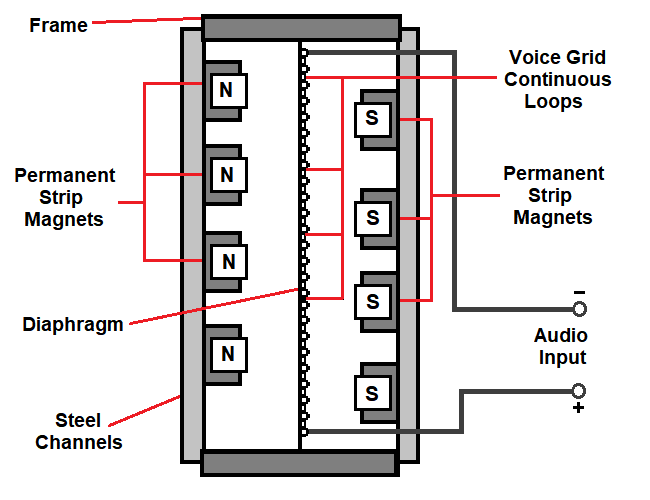
planar magnetic loudspeaker – a type of flat-panel loudspeaker that consists of two main components, a diaphragm and magnetic arrays. The term planar refers to the fact that the magnetic field is distributed in the same plane as the diaphragm. The diaphragm is a thin, lightweight film with a grid of conducting wires imbedded within it that function like a voice coil. An audio signal applied to these wires interacts with the magnetic field causing the diaphragm to move back and forth creating sound. Planar magnetic speakers are very responsive because the diaphragm can move rapidly with very great accuracy. They have an excellent frequency response and low distortion. Because they have fewer moving parts than conventional dynamic speakers, they are very durable. They also have a flat impedance over the entire frequency range, unlike conventional speakers in which the impedance varies with frequency. Unlike electrostatic speakers, planar magnetic speakers do not need step-up transformers nor a bias voltage supplies. Sometimes called a planar loudspeaker.
planar magnetic tweeter – see tweeter.
plate – (1) In a vacuum tube, the anode that produces the output signal. (2) Short for back plate. (3) Short for plate reverb.
plate reverb – (1) An artificial reverberation effect created by using an electromechanical transducer to create vibrations in a large metal sheet suspended on springs. A pickup captures the vibrations and converts it into an audio signal. It was one of the first types of artificial reverb used in recording. The very first plate reverb was the EMT 140, a 600-pound (270-kg) device introduced by the German company Elektro-Mess-Technik (EMT) in 1957. (2) A software or hardware effects processor that emulates a plate reverb. See also spring reverb.
platform – (1) A computer and its operating system (OS) that use the instruction set for a particular microprocessor, such as a Mac or Windows platform. (2) Software used to host an application or service. For example, a particular digital audio workstation (DAW) is the platform for the plug-ins that it supports and Kontact is the platform used by many virtual instruments.
platter – the round disc on a phonograph or turntable upon which a record is placed and is used to spin the record.
playback – the reproduction of recorded audio.
playback mode – the configuartion of a recorder in which one or more tracks are ready for listening to audio that previously have been recorded using the record mode or the sync mode. Also called play mode or reproduce mode.
playback equalization – an equalization curve applied during playback of a recording tape to compensate for the record equalization applied at the time of recording to minimize tape noise. Also called de-emphasis. See also CCIR curve and NAB curve.
playback head – the head on a tape recorder that converts the magnetic signal on a recording tape to audio signals. Sometimes called a replay head or reproduce head or repro head for short. See tape machine for diagram.
play by ear – (1) To be able to play a piece of music after hearing it a few times, without reading the music. (2) To play a musical instrument well, without any formal training.
player piano – a self-playing piano, which has a pneumatic or electro-mechanical mechanism that plays the piano using pre-programmed music recorded on piano rolls. Modern versions of player pianos use MIDI-encoded music stored on disks or CDs. Also known as a pianola.
playlist – (1) A list of the recorded music to be broadcast on the radio during a particular program or time period. (2) A list of media files to be played on a portable media player, computer, or other device, either sequentially or randomly. (3) A group of clips on the same audio or MIDI track in a DAW that allow the user to create alternate takes or edits of a performance. This allows the user to choose the best take or make a comp by choosing the best portion of each take. Other DAWs refer to this as an edit list, play order list, take, take folder, track alternative, comp track, or multi-lane. Sometimes spelled play list.
play mode – see playback mode.
play order list – see playlist, definition #3.
plectrum – see pick.
PLL – Phase Lock Loop.
plosive – the sound made when air is suddenly released resulting in a popping sound on a microphone, for example, when singing or saying words beginning with letters such as “P” and “B.” Compare with aspiration. See also blast.
PLOUD – the European Broadcast Union (EBU) group that works on loudness issues, especially as they pertain to the broadcasting industry and manufacturers of equipment used within the industry.
PLR – Peak-to-Loudness Ratio.
pluck – to pull and release a string on an instrument, such as a guitar, causing the string to vibrate, using either a finger or a pick. Compare with strum.
plug – a male connector on a cable that mates with a jack.
plug board – see power strip.
plugin – a software program that is added to and works through a digital audio workstation to provide additional effects. Sometimes spelled as the less-preferred plug-in. Also called an add-in or add-on.
plugin architecture – see plugin format.
plugin delay compensation (PDC) – see delay compensation.
plugin format – the interface that allows a plugin to communicate with a DAW in order to work on the audio file. Common formats include VST, AU, RTAS, and AAX. Also called a plugin interface or plugin architecture.
plugin interface – see plugin format.
PM – Personal Monitor.
PNC – Preferred Noise Criteria. See noise criteria.
PNS – Perceptual Noise Shaping.
PO 316 plug – see gauge B phone plug.
podcast – (1) A digital audio file of information or a program that can be downloaded from the internet to a computer or portable media player, often presented as a series of programs to which people can subscribe and listen to on a regular basis. (2) To make a digital audio file that can be downloaded as a podcast.
PoE – Power over Ethernet. A method for supplying electrical power to a device directly from the data cables in a wired Ethernet local area network (LAN) instead of using power cords.
point of first reflection – see first reflection point.
point of initial reflection – see first reflection point.
point stereo – see channel coupling.
point-to-point construction – see point-to-point wiring.
point-to-point wiring – a method of constructing electronic circuits in which individual components are connected by wires usually by hand. This was the method of building circuits before the printed circuit board (PCB) came into general use. PCBs are generally more easily massed produced because the process can be automated. Point-to-point wiring is still sometimes used in high-quality devices that are hand-built. Sometimes called point-to-point construction.
point source – a theoretical concept that assumes an energy source, such as sound, emanates from an extremely small point. This concept is used to simplify calculation for speakers, acoustics, and other audio phenomena. In reality, sounds usually are projected from much larger sources, such as a 6-inch cone.
POLAR™ – Performance Oriented Loop Audio Recording. A trademark of MOTU for a function in Digital Performer that allows continuous recording of loops, overdubbing each pass to build layers of audio. POLAR records audio entirely into RAM, rather than writing it to a hard disk. See loop recording and play list.
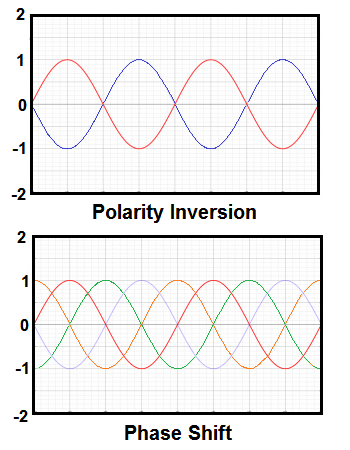
polarity – the direction or charge indicated as positive or negative of an electric current, an audio signal, or a magnetic force. Polarity and phase are often used interchangeably, but that is incorrect. Polarity is simply a reference to the position of a signal or voltage above or below the median line. Two identical signals of opposite polarity are 180 degrees out of phase with each other at all frequencies. Phase refers to a delay in the wave.
polarity flipping – slang for polarity inversion.
polarity inversion – (1) To change (reverse or invert) the direction of an electric current, an audio signal, or a magnetic force from positive to negative or vice versa, equivalent to changing the phase of a signal by 180 degrees. With an analog signal, the voltage is changed from positive to negative, which reverses the current flow. With a digital signal, resersing polarity flips the waveform so that positive values become negative and vice versa. Sometimes incorrectly called phase inversion or phase reversal. (2) The condition of one channel of a stereo signal being reversed. When this happens with a loudspeaker, it results in phase cancellation which distorts the stereo image and causes loss in the bass frequencies. Also called polarity reversal, reversed polarity, inverted polarity, polarity flipping, or signal flipping.
polarity reversal – see polarity inversion.
polization voltage – see polarizing voltage.
polarizing voltage – the voltage applied to the plates of a capacitor in a condenser microphone. Also called polization voltage.
polar graph – a circular plot or graph in which the location of a point is determined by its distance and angle from a fixed point at the center. Microphone polar patterns and speaker radiation patterns are presented on this type of graphs.
polarization – (1) The process of inducing positive and negative electric charges in an object, such as a condenser microphone capsule. See polarize. (2) The phenomenon in which waves of light or other electomagnetic radiation are restricted to one direction of vibration. British spelling polarisation.
polarize – to induce positive and negative electric charges in an object, such as a condenser microphone capsule. Condenser microphones may be internally polarized (electret) or may be externally polarized using phantom power. British spelling polarise.
polarized – designed in such a way that a plug, especially an electric plug, or jack (outlet) can fit together in only one direction, keeping positive connections positive and negative connections negative.
polarized light – light which is filtered so that the vibrations oscillate in only one direction perpendicular to the direction of propagation. Ordinary light light vibrates in many differenct planes, but polarized light vibrates in only one.
polarizing voltage – see polarize.
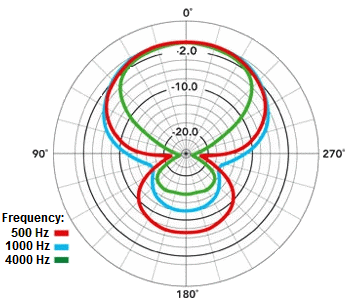
Compare with
Pickup Pattern
polar pattern – a circular plot that indicates the directional response of a microphone at various frequencies. A polar pattern provides greater detail than a pickup pattern, although they are often used interchangeably. There are three major categories of microphone directionality: omnidirectional, unidrectional, and bidirectional. Unidirectional can be further refined into five patterns for a total of seven microphone polar patterns: (1) omnidirectional, (2) cardioid, (3) subcardioid, (4) supercardioid, (5) hypercardioid, (6) lobar (shotgun), and (7) bi-directional (figure-eight). Also called polar response or polar response curve. See chart showing characteristics of directional microphones.
polar response – see polar pattern.
polar response curve – see polar pattern.
pole – (1) See slope, definition #3. (2) See magnetic pole.
pole piece – (1) A piece of metal with high magnetic permeability that concentrates and directs the magnetic field produced by a magnet. It is attached to a magnet to effectively extend its pole. Pole pieces are used to maximize the efficiency of devices like loudspeakers, magnetic cartridges, and pickups. Pole pieces are used because magnets are difficut and expensive to fabricate in complex shapes. (2) The part of a speaker driver that guides the movement of the voice coil former allowing it to move in and out. (See diagram.)
pole-zero matching – see pole-zero mapping.
pole-zero mapping (PZM) – a method of designing filters, using a formula to determine the poles and zeros, which are then mapped. A pole is a single-frequency point of increasing gain in a filter, while a zero is a single-frequency point of decreasing gain. Using an RC circuit filter design, a single-RC circuit (having one capacitor and one resistor) is a one-pole filter. A two-pole filter has two RC circuits, and so on. A one pole filter will generally provides a rolloff of about 6 dB per octave, while a two-pole filter has about 12 dB per octave, with more poles having steeper rolloffs. Also called matched Z-transform method, pole-zero matching, or matched pole-zero mapping.
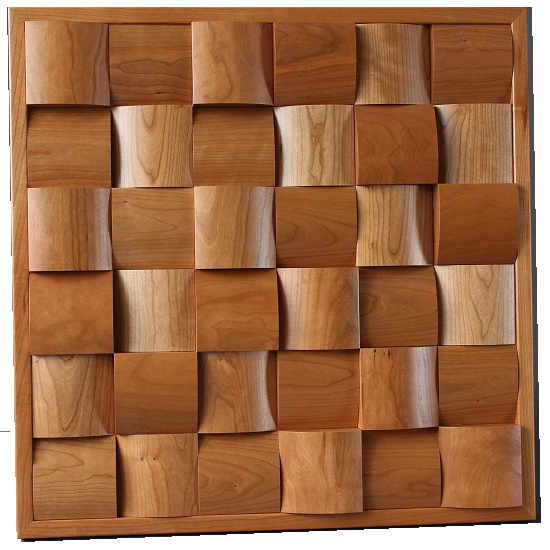
Polycylindrical Diffusers
polycylindrical diffuser – a diffuser consisting of a convex curved surface, typically cylindrically shaped wood panelling, that re-distributes sound energy based on the radius of curve and angle of incident sound energy. A polycylindrical diffuser neither decrease the acoustic energy, nor changes the phase of the energy. The effectiveness of this type of diffuser is determined by the depth, width, and radius of the curve. The low-frequency cutoff depends on the length of the chord (the line segment connecting two points on the circumference of a circle). When next to hard surfaces polycylindrical diffusers can produce unpleasant effects, but when properly located in clusters, they produce a completely neutral sound, which psychoacoustically sounds bigger. Because polycylindrical diffusers are one-dimensional (sound is dispersed in the same plane as the radius), it is advantageous to use clusters where adjacent diffusers are rotated 90° from one another. Also called barrel-shaped diffuser.
polydirectional microphone – see switchable pattern microphone.
polyester – the material commonly used as a base for magnetic recording tape, having essentially replaced acetate film. It is a film of biaxially-oriented polyethylene terephthalate (BoPET), a polyester made by stretching polyethylene terephthalate (PET) film. It is used in many application beside recording tape because of its high tensile strength, chemical and dimensional stability, transparency, and heat resistance. The most common trade name is Mylar, a trade mark of DuPont.
Polyhymnia International – a recording and mastering company formed when former employees bought the Philips Recording Center in Baarn, Netherlands, after it was shut down when Philips Classics was merged into the Decca Music Group in 1999. They also opened Pentatone Records, which specializes in SACD releases.
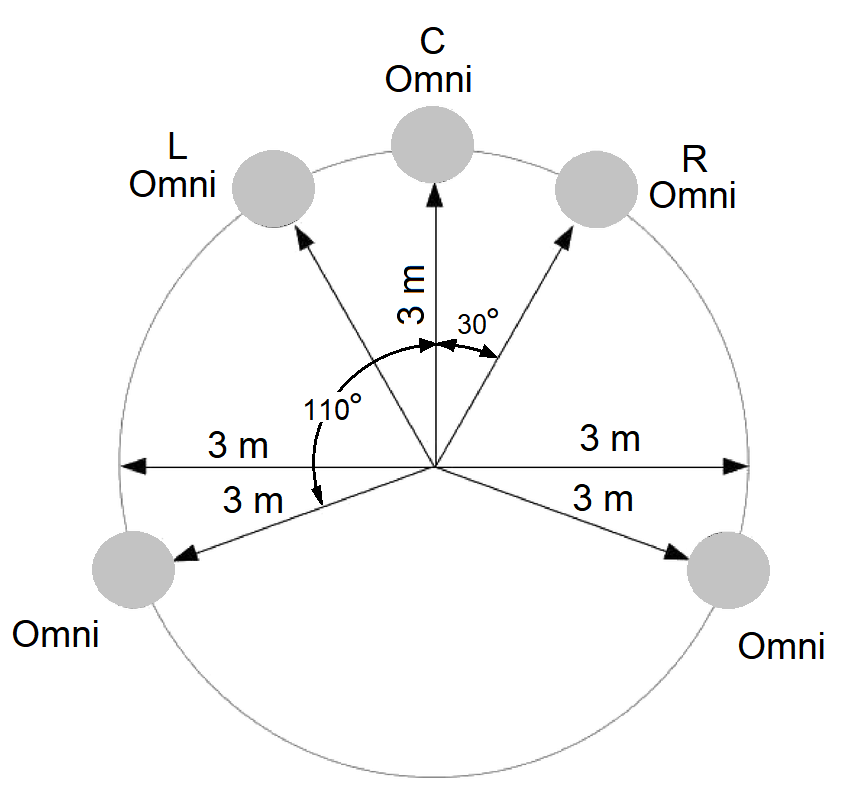
Polyhymnia pentagon – a surround sound microphone technique proposed by Polyhymnia International (formerly Phillips Classics). Five omnidirectional microphones are arranged according to the loudspeaker arrangement as defined by ITU-R BS775, with the recorded signal from each microphone being panned into a corresponding speaker from this recommendation. The five microphones are placed on a circle with a radius of 2 meters (6.5 ft). The angle between the center mic and the left and right mics is 30°. The angle between the center and the surround mics is between 100 and 120°, with 110° being the most common setting. The length of the radius can be adjusted depending on the size of the ensemble, as well as the size of a room. This technique is sometimes described as a multichannel version of the Decca Tree system.
polyphonic – capable of playing more than one note at a time. For example, an organ is polyphonic while a clarinet is monophonic.
polyphonic pickup – see divided pickup.
polyphony – (1) A style of music that simultaneously combines several parts, each forming an individual melody and harmonizing with the other. (2) The ability of a synthesizer or electronic instrument to play more than one note at one time. The opposite of monophony.
polyurethane binder deterioration – see sticky-shed syndrome.
polyvinly chloride (PVC) – a plastic material from which, among other things, is manufactured phonograph records. In actuality, the material is a copolymer of vinyl chloride and vinyl acetate. Since the advent of the LP, PVC has been the predominant material for making records. Called vinyl for short.
poly WAV file – a BWF file format containing multiple tracks and metadata that identifies the channels and other information. Such files often are used for on-location recordings and post-production work. Some DAWs and audio programs are able to import poly WAV files directly or to split them up into their individual mono WAV files. Also known as poly.wav or .wav poly.

pop – (1) See plosive. (2) See clicks and pops
popcorn noise – noise caused by defective integrated circuits that sounds like popcorn popping. It has been traced to metallic impurities. Also called burst noise.
pop filter – a material or screen placed between the singer and the microphone to reduce the popping sound created by plosives. Also called a pop shield. See also windscreen.
pop shield – see pop filter.
porous absorber – an absorber made of a material with an open structure that allows sound to enter and be converted to thermal energy at the surface of pores. Examples include foams, mineral fibers, fabrics, and carpets. Porous absorbers act on sound particle velocity, while membrane absorbers act on sound pressure. At a hard reflective surface, particle velocity drops to zero, but sound pressure reaches its maximum. For this reason porous absorbers are less effective at surface boundaries. Porous absorbers are effective on mid to high frequencies. Also called a resistive absorber because it causes the air molecules to resist motion or velocity absorber because it reduces the sound velocity. See also resonant absorber and acoustic treatment.
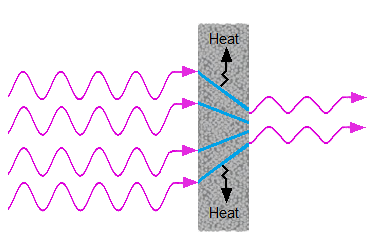
port – (1) A receptacle or jack into which an audio signal can be connected. Also called an audio port. (2) An opening or vent in a speaker cabinet. See ported speaker.
portable digital player – see media player.
portable keyboard – see electronic keyboard.
portable media player – see media player.
portable music player – see media player.
portable sound systems – sound systems consisting of amplifiers, speakers, mixers, microphones, and other equipment that can easily be carried from one venues to another, used as public address systems or for use by performing artists.
portable studio – a device combining a mixer and recorder in one unit to provide for the capability of remote recordings. These are usually digital and record to a hard drive, but earlier models were analog and used cassettes. Also called a recorder-mixer. See also Portastudio.
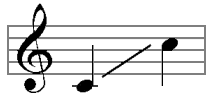
Symbol
portamento – (1) To smoothly slide from one note to another. Although similar to glissando, it is slightly different as glissando is smoother and more continuous, while portamento is a more rapid pitch change that occurs at the end of the note. It differs from legato, which is playing notes contiguously by jumpinmg from one note to the next.Portamento is Italian for “carriage” or “carrying.” Also called glide. (2) A setting on some synthesizers that causes notes to be played in a portamento style. The amount of time to slide from one note to the next may be adjustable, fixed, or scaled (determined by the distance between the notes).
Portastudio – a four-track recorder that used standard cassette tapes that was introduced in 1979 by TASCAM (now a division of TEAC) . The Portastudio 144, the world's first cassette-based multitrack recorder, was followed by several other models. Although the term Portastudio is a trade name of TASCAM, it is often used generically for similar multitrack recorders made by other manufacturers. Most of these machines were four-track models, but some six-track and eight-track units were also produced. Newer models are digital, record to a hard drives, and have as many as 32 tracks of audio. See also portable studio.
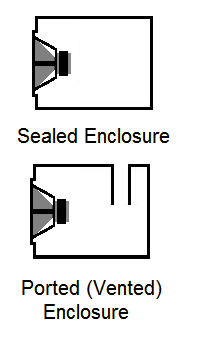
ported speaker – a speaker design in which the enclosure has a vent or hole in the cabinet that is attached to a tube, which minimizes pressure buildup within the cabinet. Such speakers are much more efficient than acoustic suspension designs, which use sealed enclosures. Ported speakers have improved low-frequency output and can use smaller enclosure sizes than non-ported designs. Also known as bass reflex, vented speaker, vented box, or reflex port.
positional reference – a reference used to provide location information between devices for the purpose of time code.
positive – (1) A number or value greater than zero. The opposite of negative. (2) In a plot of waveforms, audio signals, and similar quantities, the portion that is above the cener line (which is usually zero, but not always). See also absolute polarity. (2) One of the two fundamental types of electric charges, the other being negative. An atom with more protons than electrons will have a positive charge. A positively charged object will repel other positively charged objects and attract negatively charged objects.
positive flanging – see additive flanging.
post – (1) Means “after,” as opposed to pre, which means “before.” In the recording studio, it is used to refer to signals to which effects have been added, such as post-equalization, post-effects, or post-fader. (2) An abbreviation for post production. (3) See binding post.
postage stamp effect – see windowboxing.
post echo – the repetition of a sound occurring after the original sound caused by tape print-through.
post-fader – a send on a console, mixer, or DAWs after the level adjustment (fader) in the signal path, so that when the level is adjusted, it affects the signal being sent. Post-fader sends are normally used to send effects from a particular channel, because the channel fader controls both the level sent to the main mix as well as the level of send. So an adjustment of the fader wil retain the relative proportion of wet and dry signal. If the wet signal level did not follow the dry signal level, the affected signal would still be heard after the channel fades out. The opposite of pre-fader. Also called post-fade send.
post-fade send – see post-fader.
post production – (1) Tasks that have to be done after mixing is finished and before making the master. These include additional editing, sequencing of tracks for an album, and the addition of metadata such as title, artist, and ISRC codes. (2) Audio post production for video (APPV). Sometimes spelled postproduction or post-production. Called post for short.

(Definition #2)
post-ringing – see ringing.
post roll – (1) The amount of time set for an audio track to play after a punch in. (2) The amount of time a tape machine runs past a desired end point. See also pre-roll.
post synchronization – see automatic dialog replacement.
pot – (1) Short for potentiometer. (2) A substance used by some musicians to take the “edge” off before a performance or recording session.
potential – the work done per coulomb of test charge moving a small positive test charge from the negative terminal to some point in a circuit. Often represented by the Greek letter phi (Φ). Potential difference is the work done per coulomb of charge moving a small positive test charge between any two points. Potential difference is measured with a voltmeter.
potential acoustic gain (PAG) – a measure of the gain that a sound system can achieve at or just below the point at which feedback occurs. See also gain before feedback.
potential difference – see potential.
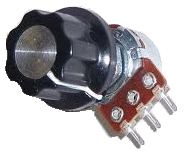
potentiometer – a device (typically attached to a knob or slider) used to adjust some parameter of an audio signal corresponding to its position. Called a pot for short. See also taper.
potentiometer law – see taper.
powdered iron – see powdered metal.
powdered metal – microscopic-sized particles of iron used in place of iron oxide for the magnetic coating on metal particle tape. Also called powdered iron.
power (P) – (1) The measurement of the ability of an electrical current to produce work per unit time, measured in watts. One watt equals one joule per second. Power also equals volts times amperes (1 joule/coulomb x 1 coulomb/sec = 1 joule/sec = 1 watt. Power can be calculated by P = I X R = V/R X V = V2/R, where I is current, R is resistance, and V is voltage. From this you can see that power is proportional to the square of the voltage. (2) The rate at which energy is produced by a sound source, measured in watts. Also called acoustic power or sound power. (3) The electricity supply that provides energy to appliances and other electronic devices. In the US household power is usually alternating current at 60 Hz and 110 volts. Other countries use various combinations of 110 or 220 volts at 50 or 60 Hz.
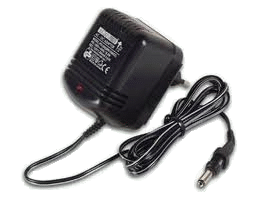
("Wall Wart")
power adapter – a small transformer that usually plugs directly in to a wall outlet and converts alternating current (ac) to a lower voltage (usually dc but sometimes ac) that can be used by an electronic device. Also called an AC adapter, AC/DC adapter, AC converter, charger (if used to recharge a battery), wall wart (slang), line lump (slang), or power brick (slang used with laptops when the transformer does not plug into the wall).
power amplifier – an electronic device that takes a line level signal and boosts it to a level where it will drive a loudspeaker.
power bar – see power strip.
power board – see power strip.

("Power Brick")
power brick – see power adapter.
power chord – a chord consisting of a root note and its fifth interval, and omitting the third. Typically, power chords are played on amplified electric guitars, often with distortion, and are frequently used in rock music. Also called a fifth chord.
power cord – the wire that plugs into a wall outlet and provides electricity from the power grid to an appliance or other electronic device. Also called a line cord or mains cable (British).
power level (dBW or dBm) – a measure of power as indicated by the logarithm of the power relative to a reference value of 1.0 watt (W), expressed as dBW), or referenced to 1.0 milliwatt (mW), expressed as dBm).
power output – the rate of energy produced by an amplifier to a load (typically a loudspeaker), measured in watts.
power spectral density (PSD) – the average power that an RF signal carries in 1 Hz of bandwidth, expressed in watts/hertz (W/Hz). The PSD can be calculated using:
PSD = P/B
where PSD is the power spectral density in W/Hz, P is the transmitted power in watts, and B is the signal bandwidth in hertz.
power strip – a unit that provides for multiple electrical outlets to be conncected to one wall outlet. Sometimes called a mains multiblock (British), multiblock, extension block, power board, power bar, plug board, or trailer lead.
power source – see power supply.
power supply – (1) A circuit that provides voltage and current needed to run a device. The efficiency of a power supply is usually represented by the Greek letter eta (η). Sometimes called a power supply unit (PSU). (2) A source of power. Sometimes called a power source. (3) The electricity supply. See power, definition #3.
power supply unit (PSU) – see power supply.
power surge – see transient voltage.
POW-R – Psychoacoustically Optimized Wordlength Reduction. A set of dithering and noise shaping algorithms used to reduce the bit-depth of audio files, developed by a consortium of four companies. POW-R is licensed for use in many digital audio workstations.
P-P – Peak to Peak.
PPCM – Packed PCM. See Meridian lossless packing.
PPQ – Pulses Per Quarternote. See PPQN.
PPQN – Pulses Per Quarter Note or Parts Per Quarter Note. A specification for the timing resolution of MIDI sequencers, as indicated by the number of parts into which a quarter note is divided (for MIDI systems, usually 480). Also abbreviated as PPQ. Also called ticks per quarternote (TPQ).
PPM – Peak Program Meter.
PQ subcode – data containing timing information embedded in a compact disc to allow a player to cue instantly at the beginning of each track, provide display of elapsed time, and other track information.
pre – slang for preamplifier.

preamp – short for preamplifier.
preamplifier – a device that boosts a low-level (mic-level) signal up to line level. Called a preamp or just pre for short.
precedence effect – see Haas effect
pre-chorus – a transitional section of music that occurs just before the chorus. It moves the music forward and prepares the listener, both melodically and lyrically, for the hook of the chorus. The pre-chorus varies in length from just one line to a several lines, but typically it is about four bars. Although a pre-chorus is optional, if the first verse has a pre-chorus, then all subsequent verses typically have a pre-chorus, with either the same lyrics or different lyrics. Also called transitional bridge, build, lift, or channel climb. See also bridge
precision time protocol (PTP) – a communication protocol used to synchronize clocks within a computer network, as defined in IEEE 1588. It allows for clocks to be synchronized over Ethernet networks with an accuracy of less than one microsecond. Among other things, it is used with measurement and control systems. It provides synchronization that is more accurate than network time protocol (NTP).
pre-delay – (1) The amount of time between the the incident sound and the first reflection of that sound. (2) In a reverb processor it refers to the amount of time between the original dry sound and the onset of audible reverb processing. Proper adjustment of pre-delay can greatly affect the clarity of a mix, especially with vocals. See also pre-delay time.
pre-delay time – a parameter found on many reverb units that sets the amount of time before reverb begins. See also pre-delay.
predominant chord – in music theory, any chord that normally resolves to a dominant chord. Also spelled pre-dominant.
predub – see prelay.
pre-echoes – see ringing.
pre-emphasis – see emphasis.
pre-fade listen (PFL) – a term used on consoles, mixers, and DAWs for a signal taken before the main channel fader. This signal is not affected by the fader position. It is especially useful for listening (via headphones) to an input that has the fader all the way off. In broadcast this function is often called cueing and in recording and live sound it is called soloing. See also AFL and APL.
pre-fader – a send on a console, mixer, or DAWs before the level adjustment (fader) in the signal path, so that the level can be adjusted without affecting the signal being sent. Headphone mixes are often sent pre-fader, so that fader adjustments do not affect the headphone mix. The opposite of post-fader. Also called pre-fade send.
pre-fade send – see pre-fader.
preferred frequencies – center frequencies established by ISO 3 to avoid dealing with fractional numbers when working with octave bands and one-third-octave bands. Also known as nominal frequencies.
pre-gap – see spread.
pregroove – a spiral groove stamped into the polycarbonate layer of an writable optical disc during the manufacturing process. The pregroove track is used to guide the read/write laser during writing in order to maintain accurate spacing between tracks. The spiral has a slight sinusoidal deviation from a perfect spiral, and the frequency of this sine curve is called the wobble frequency. The wobble frequency is used to synchronize the rotation speed of the disc to maintain an accurate linear velocity (the speed of the track as it passes the laser). The wobble is also modulated with a timecode reference signal called the ATIP. Sometimes spelled pre-groove.
pregroove echo – see ghosting.
prelay – transfer of various audio elements (other than those from the edit master videotape) to multitrack tape or audiohard disk for premixing. See also layback, layoff, and layover. Also called predub.
premaster – (1) The final version of a compact disc or DVD (often recorded on a CD-R or DVD-R) that is sent to a replication facility for manufacturing. (2) In predigital times the process of cleaning up and bouncing various tracks to create the final master track.
premium content – content.
premix – (1) Preparing an audio project for the mixing stage by arranging, labeling, grouping, and otherwise preparing tracks. (2) A mix of several tracks into into one audio track to be combined with one or more similarly mixed tracks to form the main or final mix. Sometimes spelled pre-mix.
preparations – see prepared piano.
prepared piano – a piano that has been altered by placing objects (called preparations) on or between the strings to change the sound and/or pitch. John Cage is usually credited with inventing the prepared piano. The preparation objects should have these characteristics: (a) They should be placed directly on or between the strings. (b) They must fit in that space. (c) They should not move when the piano is played. (d) When removed, the piano should return to its normal condition without any damage to the piano. Preparation objects are things like nuts, bolts, screws, rubber bands, etc. Technically, a tack piano is not a prepared piano because the tacks are placed on the hammers, not the strings.
prepolarized condenser microphone – see electret condenser microphone.
preproduction – all the work that takes place in preparation for a recording session, including hiring a producer, hiring session players, choosing a studio, choosing and arranging songs, etc. The term is also used for similar work done in preparation for recording video or film productions. Sometimes spelled
prerecorded tape – a magnetic tape on which sound has been recorded and offered for sale to the public. That format now is essentially obsolete.
pre-ringing – see ringing.
pre-roll – (1) The amount of time set for an audio track to play before a punch in. Pre-roll gives the musicians a chance to hear a small amount of the music prior to the punch point for context and/or to establish the rhythm and tempo. (2) The amount of time a tape machine runs before the start of a recording take. See also post roll.
presence – (1) The sense that a reproduced instrument or voice is actually present in the listening room. This effect can be enhanced by boosting equalization in the upper midrange. (2) A descriptive term for emphasized response in the 2.4 kHz to 5 kHz range, the so-called presence range.
presence peak – an increase in the frequency response of a microphone in the presence range, which tends to improve clarity, definition, and ”presence.”
presence range – the portion of the audio frequency spectrum that affects perceived presence, typically in the 2.4 to 5 kHz range. It is sometimes included as a part of the midrange frequencies. Also called middle highs.
preset – (1) A factory-programmed patch or effect for a synthesizer that cannot be changed by the user. (2) A set of factory-set parameters used to produce a particular effect on a signal processor.
PreSonus Audio Electronics, Inc. – a manufacturer of equipment and software used in live sound and recording studios based in Baton Rouge, LA.
PreSonus Studio One – see Studio One.
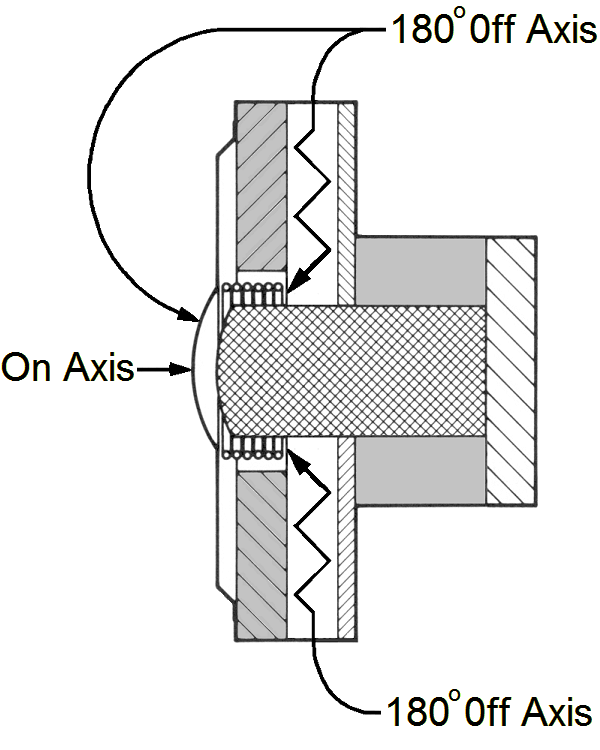
pressure (P) – the force applied on or to the surface of an object per unit area. The SI unit for pressure is the pascal (Pa), which is one newton per square meter. In US customary units it is measured in pound (force) per square inch (psi). Lower frequency sounds tend to be transmitted by pressure, while higher frequencies tend to be transmitted by particle velocity.
presure absorber – see resonant absorber.
pressure gradient microphone – a microphone that reacts to the difference in pressure (pressure gradient) between the front and back of an open diaphragm. Such microphones are very sensitive to sound from the front and rear, but not on the sides. Pressure gradient is a vector quantity (meaning it has a directional component). Since velocity is also a vector quantity, such microphones are also called velocity microphones. Contrary to the often stated definition of a velocity microphone, they do not react to air particle velocity. Ribbon microphones are velocity microphones, and the two terms are often used interchangeably. However, whereas all ribbon ribbon microphones are velocity microphones, not all velocity microphones are ribbon microphones. Contrast with the pressure microphone.
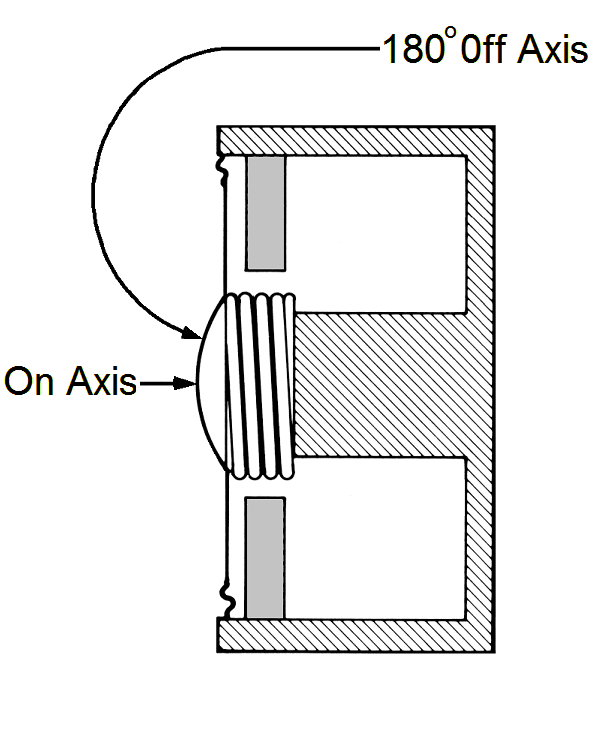
pressure microphone – a type of microphone in which the diaphragm is open on one end and sealed on the other side. Sound pressure has to move the diaphragm against the resistance created. This design is used for omnidirectional microphones. Also called a pressure-operated microphone. Contrast with the pressure gradient microphone.
pressure-operated microphone – see pressure microphone.
pressure response microphone – see microphone response types.
pressure sensitivity – see aftertouch.
pressure wave – a wave consisting of repeating patterns of high-pressure and low-pressure areas moving through a medium, such as air. Sound is a pressure wave. A plot of a sound wave is sine wave, where the peaks represent compressions, the valleys represent rarefactions, and the point where the curve crosses the zero line represents the pressure in the medium (air) with no sound.
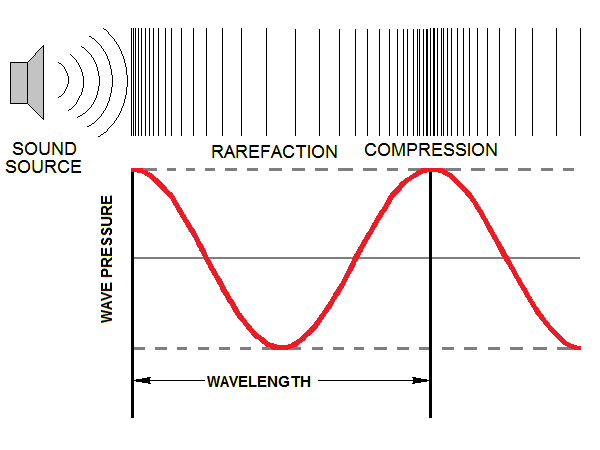
of Sound Waves
pressure zone – the area near a surface that when impacted by a sound wave the particle velocity drops to zero and the pressure increases creating a high-pressure layer near the surface. This pressure zone provides a 6-dB boost in sensitivity to a microphone placed near the surface, and hence the name pressure zone microphone (PZM), one type of a boundary microphone.
Pressure Zone Microphone™ (PZM™) – a type of boundary microphone designed to be attached to a flat surface. (Note: not all boundary microphone are pressure zone mics.) It has a diaphragm mounted parallel to a plate and is separated from the plate by a very small airspace (the pressure zone), which gives it a 6-dB boost. The pressure zone mic has a wide, smooth frequency response, even to off-axis sounds. (Trademarks of Crown International).
prestissimo – a musical term indicating an extremely fast tempo, as quickly as possible, typically 178 to 200 bpm. See chart of tempo terms.
presto – a musical term indicating an extremely fast tempo, typically 168 to 200 bpm. See chart of tempo terms.
preverb or preverberation – (1) The difference in time between a direct sound and the first reflection from a room surface. Also called initial time delay. See also reverberation. (2) A special effect produced by recording a reverberation while playing a track backwards, and then reversing it so that the reverb precedes a note rather than follow it.
preview version – see beta version.
primary – see coil.
primary coil – see coil.
primary tones – the notes on a brass instrument that can be played without the use of valves.
primary winding – see coil.
prime – see perfect unison.
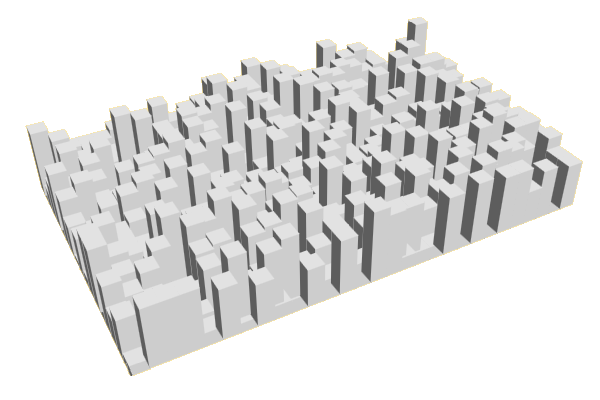
primitive-root diffuser (PRD) – a diffuser constucted using a mathematical sequence based on prime numbers and their primitive roots. While these diffusers produce a notch in their scattering response, the bandwidth of the notch is too small to cause a problem. Their performance is similar to quadratic-residue diffuser (QRDs).
print – (1) To record to magnetic tape. (2) To make a copy of a movie film. (3) A copy of a movie film. The version that is provided to a movie theater for exhibition is called the final print or release print.
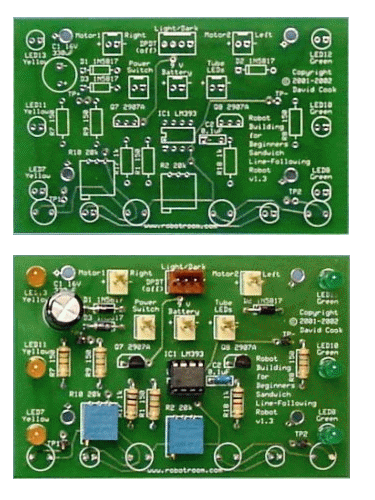
Above without Components
Below with Components
print-based noise reduction – a type of noise reduction algorithm in which a sample of noise, such as hiss or ambient room noise (the noise print), is used as a guide to match the noise to be removed. Such methods of noise reduction can sometimes result in unwanted artifacts, such as twittering or birdies.
printed circuit board (PCB) – a thin sheet of non-conductive material onto which thin strips of a conducting material such as copper have been attached or printed to simplify assembly of an electronic circuit or circuit board. Components are soldered to the printed circuit board rather than wiring them individually, which is called point-to-point wiring.
printing resolution – see resolution, definition #4.
print master – the final edit of a movie soundtrack that is ready to be transferred directly to a film track negative or a magnetic stripe print with all edits, equalization, and noise reduction in place. Also called a running master.
print resolution – see resolution, definition #4.
print through – the undesired transfer of a magnetic signal from one layer of recording tape to another. Also called interlayer transfer or layer-to-layer signal transfer.
pristine – a descriptive term for a sound that is very clean and transparent.
PRO – Performance Rights Organization.
pro audio – short for professional audio.
processing – short for signal processing.
processor – (1) Short for signal processor. (2) The part of a computer CPU that receives instructions and carries out actions or calculations according to those instructions.
ProDigi – a professional audio, reel-to-reel, digital audio tape format with a stationary head developed by Mitsubishi. Available from the mid-1980s through the early 1990s, the format was similar to and competed with Sony's DASH, but like DASH never became a commercial success. ProDigi recorders were available in a 2-track version on ¼" tape, 16-tracks on ½" tape, and 32-tracks on 1" tape. All of the machines required the use of metal-particle magnetic tape.
producer – (1) The person who manages and supervises the recording of one or more songs, with the desired quality and within budget. The duties of a producer vary, but among other things the producer may collaborate with the artists to select songs, select the audio engineer, arrange for musicians at the recording session, make suggestions to improve performances, and work with the engineer to select and edit sounds and effects. Also called a record producer or music producer. (2) The person who oversees the production of a movie. Either employed by a production company or working independently, producers plan and coordinate various aspects of film production, such as selecting the script, coordinating writing, directing, and editing, and arranging financing. Also called a movie producer or film producer.
Producers and Engineers Wing – a division of the Recording Academy, formerly the Music Producers Guild of the Americas (MPGA), a professional organization for music producers and audio recording engineers. It was merged with the Academy in 2000.
production – (1) The recording process to produce a song. (2) The processes and actions carried out by a producer. (3) A recording that is enhanced with special effects. (4) The process carried out to create a movie or a radio or television program or commercial.
production music – see library music.
production music library – a collection of recorded music held by companies, who own or manage the copyright to the music, which is licensed to clients for use in film, television, and radio production. See also library music.
production sound – see location sound.
production studio – a recording studio that specializes in producing commercials and radio programs.
professional audio – (1) An industry that produces and reproduces sound. Among other things, professional audio includes broadcast radio and television, recording studios, mastering studios, sound reinforcement, professional DJs, public address systems, and movie theater sound. (2) The equipment used by this industry. The term is often used to distinguish it from consumer audio equipment, which is usually confined to the reproduction of sound in the home. Called pro audio for short.
Professional Audio Manufacturers Alliance (PAMA) – A world-wide trade organization of senior executives of manufacturers of professional audio products, with the goal of promoting growth and profitability for the professional audio manufacturing industry.
profiling amplifier – see amplifier profile.
program – (1) To create a synthesizer patch. (2) A synthesizer patch. (3) The audio or video signal of interest in a given system as opposed to noise. (4) Coded instructions for the automatic performance of a particular task by a computer. (5) To write coded instructions for the performance of a particular task by a computer. (6) A show on radio or television. (7) A continuous segment of audio upon which a loudness measurement is made under the ITU BS.1770 standard, such as a television program, advertisement, or music track. British spelling is programme.
program bus – a bus or output line that feeds audio to a track on a tape machine. British spelling is programme bus.
program chain – see signal chain.
programming – (1) The process of scheduling radio or television programs. (2) The scheduled programs for a particular radio or television station.
program loudness – see integrated loudness.
program mixer – a mixer on a console consisting of an inputs, outputs, combining amplifiers, and program buses. British spelling is programme mixer.
progressive scan – a technique for displaying video images in which all the lines of each frame are drawn in sequence, as opposed to interlaced video used in traditional analog television systems where one field was displayed on the odd lines and a second field on the even lines of each frame. Also called noninterlaced scanning.
project – (1) The term used by some DAWs for a session or a single song. (2) The planning and execution of the tasks needed to record an album.
project document – see session file.
project file – see session file.
projector – a device for displaying still images, motion pictures, or digital images onto a screen. Also called a film projector, movie projector, or motion picture projector.
project studio – originally a small, personal recording studio, usually located in a home or garage. However, today it can be anything from a personal home studio to a small professional studio.
project template – see template.
propagation – see sound propagation.
proportional-Q equalizer – a graphic or rotary equalizer in which the bandwidth (Q) changes in proportion to the amount of boost or cut in level. Although sometimes called a variable-Q equalizer, that term is less accurate in that the user cannot adjust the Q on such equalizers. See also constant-Q equalizer.
Propellerhead Software – a music software company founded in 1994 and based in Stockholm, Sweden, and the creator of the computer program Reason.
prosumer – a slang term referring to a piece of gear that is between the consumer and professional market. It may be designed for the consumer market, but it has professional features and capabilities. See also semi-professional.
protected channel – a US TV channel in which TVBDs are prohibited as designated for a given location per FCC rules.
protective earth conductor (PEC) – a conductor that connects between the protective earth terminal (PET) and an external protective earthing system. In the US this is called an equipment grounding conductor.
Pro Tools® – the trade name used by Avid for several versions of its digital audio workstation (DAW). Digidesign who originally designed Pro Tools was bought by Avid, who phased out the Digidesign name in 2010. Pro Tools typically offers three levels of their software, an entry-level, a mid or semi-pro level, and a pro-level. Over the years, the names for these levels have changed, sometimes confusingly so. The current levels of Pro Tools are: Pro Tools Artist, Pro Tools Studio, and Pro Tools Flex. Pro Tools is often abbreviated as PT.
Pro Tools (Standard) – the semi-professional version of Pro Tools, which provided for 128 audio tracks, 32 inputs, and 128 Aux tracks. Standard Pro Tools, which was for a time called Pro Tools native and then simply Pro Tools, was sometimes informally called Pro Tool Vanilla. It replaced Pro Tools LE. Pro Tools native should not be confused with Pro Tools HD|Native. Standard Pro Tools was replaced by Pro Tools Studio.
Pro Tools Artist – Avid's entry-level digital audio workstation (DAW) which replaced Pro Tools|First in 2022. Pro Tools Artist has many addtional features over Pro Tools|First. It provides for 32 audio tracks, 32 auxiliary tracks, 32 instrument tracks, and 64 MIDI tracks.
Pro Tools|First – a free introductory, streamlined version of Pro Tools aimed at beginners. Although it did not have all the functionality, it had much of the capabilities and worked just like regular Pro Tools. It was replaced by Pro Tools Artist.
Pro Tools Flex – Avid's top-level digital audio workstation (DAW), designed for large music recording studios and audio post facilities. Pro Tools Flex includes Pro Tools Ultimate, which has all the features of Pro Tools Studio plus many additional features, such as 7.1 surround, Atmos, and Ambisonics mixing, and unlimited busses. Pro Tools Ultimate now provides 2,048 audio tracks, 1,024 auxiliary tracks, 512 instrument tracks, and 1,024 MIDI tracks. With 256 channels of native I/O, Pro Tools Flex can accommodate very large tracking and mixing sessions. Pro Tools Flex is compatible with Pro Tools HDX and HD Native systems.
Pro Tools HD – see Pro Tools|HDX.
Pro Tools HD|Native – see Pro Tools|HDX.
Pro Tools|HDX – the professional version of Pro Tools introduced by Avid in 2011. The HDX line had greater performance in dynamic range, latency, and computational power than the older Pro Tools HD line, which it replaced. Pro Tools|HDX had two versions: HD|Native and HDX. HD|Native systems used the host's CPU for all audio processing, but maintained the advanced workflows and sound quality of Pro Tools|HD. HDX used up to three HDX cards per system, which provided DSP processing and relieved the host from this processing. TDM technology was no longer supported with HDX products. HDX has been replaced by Pro Tools Ultimate.
Pro Tools LE – the semi-professional version of Pro Tools, which was discontinued with the introduction of Pro Tools 9. It was replaced with what was then called standard Pro Tools. Some entry-level versions of Pro Tools, which had less power than Pro Tools LE, included Pro Tools SE and Pro Tools M-Powered.
Pro Tools M-Powered – see Pro Tools LE.
Pro Tools Native – see standard Pro Tools.
Pro Tools SE – see Pro Tools LE.
Pro Tools Studio – Avid's mid-level digital audio workstation (DAW), which replaced Pro Tools (Standard) in 2022. Designed for project studios and advanced home recordists, Pro Tools Studio provides for 512 audio tracks, 128 auxiliary tracks, 512 instrument tracks, and 1,024 MIDI tracks, plus 64 tracks of native I/O for large recording sessions. It includes surround and Atmos mixing, which previously was only available with Pro Tools Ultimate.
Pro Tools|Ultimate – the professional version of Pro Tools, which replaced Pro Tools|HDX. It allowed 192 inputs, 1,024 MIDI tracks, 512 instrument tracks, 64 video tracks, 7.1 surround, Atmos and Ambisonics mixing, and unlimited busses. It is now part of Pro Tools Flex.
| Pro Tools Version | Year Released |
|---|---|
| Sound Designer | 1985 |
| Sound Designer Universal | 1987 |
| Sound Tools Sound Designer II |
1989 |
| Pro Tools | 1991 |
| Sound Tools II | 1992 |
| Pro Tools II | 1993 |
| Pro Tools TDM Pro Tools III |
1994 |
| Pro Tools PCl | 1996 |
| Pro Tools 4 Pro Tools|24 |
1997 |
| Pro Tools|24 MIX | 1998 |
| Pro Tools 5 Pro Tools LE |
1999 |
| Pro Tools Free | 2001 |
| Pro Tools|HD | 2002 |
| Pro Tools 6 | 2003 |
| Pro Tools 7 Pro Tools M-Powered |
2005 |
| Pro Tools 8 | 2008 |
| Pro Tools 9 | 2010 |
| Pro Tools 10 Pro Tools|HDX |
2011 |
| Pro Tools 11 | 2013 |
| Pro Tools 12 Pro Tools|First |
2015 |
| Pro Tools 2018 Pro Tools|Ultimate |
2018 |
| Pro Tools 2019 | 2019 |
| Pro Tools 2020 | 2020 |
| Pro Tools 2021 | 2021 |
| Pro Tools 2022 Pro Tools Artist Pro Tools Studio Pro Tools Flex |
2022 |
proximity effect – (1) The increase in bass frequencies as the sound source gets closer to a directional microphone. This effect is the result of the design of a unidirectional microphone and is essentially absent in omnidirection microphones. Also called bass tip-up. (2) In electromagnetism, the phenomenon that occurs when two or more conductors carrying high alternating current are placed close together so that their electromagnetic fields interact and the current in each conductor is redistributed so that a greater current density is concentrated in that part of the strand farthest from the interfering conductor. This effect causes an increase in the effective resistance of the circuit, which increases with frequency.
PRS – Performing Rights Society. See MCPS-PRS.
PRS for Music – see MCPS-PRS.
pseudo-balanced line – similar to a balanced line except that the third line (pin-3 for an XLR connector or the ring lead for an ¼-inch TRS connector) has a resistor equal to the resistance of the other two lines. Also called a quasi-balanced line.
pseudo-quadraphonic – see ambience extraction.
pseudo stereo – see simulated stereo.
PSD – Power Spectal Density
PSI Audio – a company that designs and manufactures speakers and studio monitors, loocated in Yverdon-les-Bains, Switzerland. It was founded in Lausanne, Switzerland, in 1977 by Alain Roux as Roux Electroacoustique. In 1988, the company became Relec SA and was relocated to a new facility at its current location. In 2004, Relec SA introduced the PSI Audio brand.
PSU – Power Supply Unit. See power supply.
psychoacoustics – the scientific study of the way sounds and audio information is interpreted by the human brain. Some of the psychoacoustic effects include frequency masking, temporal masking, sound localization, the Haas effect (precedence effect), and others.
psychoacoustic surround sound – see transaural stereo.
PT – common abbreviation for Pro Tools.
Ptolemaic comma – see syntonic comma.
Ptolemaic tuning – see just intonation.
PTP – Precision Time Protocol.
PTZ – Pan-Tilt-Zoom.
public address (PA) – (1) The amplification and distribution of audio signals to loudspeakers for a live audience. (2) A system of equipment, including a mixer, amplifiers, speakers, and other equipment, used to provide PA sound.
public broadcasting – radio and television stations that broadcast programming as a public service. In many countries, funding is provided by the government or through annual fees charged on receivers. Public broadcasters in the US receive some funding from federal and state governments, but most financial support comes from foundations and businesses, along with contributions from listeners through pledge drives. Most are operated as non-profit companies and are associated with colleges and universities.
public domain – a designation for content that is not protected by any copyright, patent, or other restriction and, therefore, belongs to the public at large. Such works may be freely copied, shared, altered, or republished by anyone. A work is in the public domain because the copyright, patent, or other restriction has expired or it never had such protection, sometimes being placed in the public doman purposely. Copyright and other restrictions vary by type of content and by country.
public performance rights – see performance rights.
public performance track – see backing track. Also called a public performance version or PA track.
public radio – see public broadcasting.
public television – see public broadcasting.
publisher – a company that administers copyrights and licensing of music to performers, record companies, and others wanting to record the music. They also collect royalties on behalf of the songwriter. Also called a music publisher or publishing company.
publishing company – see publisher.
puffy – a descriptive term for sounds with a bump in frequency response around 500Hz.
pull down – a method of converting differing video frame rates to a compatible fortmat for viewing. See 3:2 pull down. Also spelled pulldown and pull-down.
pulse amplitude modulation (PAM) – the first step in digital sampling, in which pulses are created in proportion to the amplitude of the analog audio signal. This process is followed by pulse code modulation (PCM), an encoding step. See also pulse wave modulation.
pulse code modulation (PCM) – a method of digitally encoding and decoding audio signals. It is the method of encoding audio in wav files, compact discs, and many other applications. The PCM method samples the amplitude of the analog signal at regular, uniform intervals, and each sample is quantized to a value within a range of digital steps. LPCM (linear pulse code modulation) is PCM with the amplitude represented in a linear fashion. With DPCM (differential pulse-code modulation) the amplitude is represented as the difference from the previous amplitude sample, but also involves some predictive functionality. ADPCM (adaptive differential pulse-code modulation) is a variation of DPCM that varies the size of the quantization step to further reduce the bandwidth for a given signal-to-noise ratio. See also pulse width modulation and pulse amplitude modulation.
pulse-density modulation (PDM) – a method of digitally encoding and decoding audio signals. It is the method of encoding audio in SACD discs. PDM encodes the relative density of pulses corresponding to an analog signal, as opposed to PCM that encodes amplitude values into pulses of different sizes. Pulse Width Modulation (PWM) is a variation of PDM in which all the pulses are contiguous in the digital signal.
pulse-duration modulation (PDM) – see pulse width modulation.
Pulse Techniques, Inc. – a company formed in Teaneck, New Jersey, in 1953 by Eugene (Gene) Shenk and Oliver (Ollie) Summerlin, which used the tradename of Pultec. Although they made several products for the recording studio, they are probably best known for the Pultec EQP-1A equalizer. In 1981 after attempts to sell the company failed, they closed their doors.

pulse wave – a waveform similar to a square wave, but consisting of short pulses without the symmetrical shape of a perfect square wave. Pulse waves sound brighter and thinner than square waves, and are often used in synthesizers. The timbre can be changed by modulating the width of the pulse (pulse width modulation). See also sawtooth wave, sine wave, ramp wave, and triangle wave.
pulse width – see pulse width modulation.
pulse width modulation (PWM) – a method for obtaining analog results using digital methods. Using digital control to create a square wave, a signal can be switched between on and off. This on-off pattern simulates voltages between full on and full off by changing the amount of the time the signal is on versus the time that the signal is off. The duration the signal is on is called the pulse width. Various analog values can be obtained by modulating the pulse width. When the on-off rates are fast enough, the signal acts like an analog signal. PWM is used in certain classes of amplifiers and in other devices. Also called pulse-duration modulation (PDM).

Pultec EQP-1A – an all-tube equalizer designed and manufactured by Pulse Techniques, Inc. Beginning in 1956 they started with the EQP-1, which had a limited number of frequencies. In 1960-61, the number of frequencies was expanded when the EQP-1A replaced the EQP-1, a 3-rack unit. In 1970, it was replaced by the 2-rack-unit EQP-1A3, which was identical to the 1A in parts and specs. Then the EQP-1A3SS was introduced in the late 70s and featured solid-state make-up gain circuitry. Solid-state circuitry was easier to build and lower in cost and was the trend in the industry at the time. However, it was the vacuum tube version that become legend.
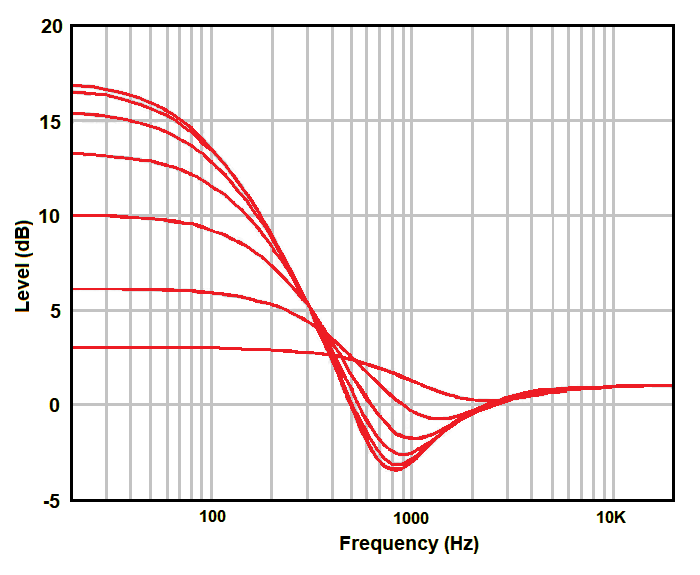
Low Cut+Boost @ 100 Hz
Pultec low-end trick – a technique that results from the fact that some equalizers, such as the Pultec EQP-1A and the Slate Digital LLC Custom Series, have a slightly lower corner frequency for the low boost shelf than they do for the low attenuate (cut) shelf. Using both a boost and a cut filter at the same time usually cancels out to produce a flat response, but with these equalizers they do not. The slight difference in the corner frequencies produces a curve that redistributes the energy in a way that results in a less honky or boxy midrange. Using a setting of 20Hz or 30Hz, kick drums, bass guitars, and synths get more weight without boosting the gain or sounding muddy. Settings of 60Hz or 100Hz work well on snare drums, acoustic guitars, pianos, and vocals, reducing boxiness and adding depth. This effect should work with emulations of these EQs as well, but may require adding two plugins in series. Also called the Pultec trick, the low-end trick, secret Pultec trick, or secret low-end Pultec trick.
Pultec trick – see Pultec low-end trick.
pumping – the mostly undesirable audible rise and fall of background noise caused by overuse of a compressor. However, pumping sometimes is used creatively to cause a pulsating, rhythmic effect, especially with drums. Also called breathing.
pump organ – see organ.
punch – the characteristic of a sound that seems to reach out and grab you. Such a sound has definition and presence. However, punch tends to be used more often with electric guitars and basses, while presence is used with both voices and instruments. See also punchy.
punch and roll – a technique used by voice over artists in which, upon making an error, they stop recording, playback a few seconds of the preceding audio, punch in prior to the point where the error was made, and continue recording with a seamless transition. This procedure eliminates the need to go back and edit files later. Sometimes spelled punch 'n' roll.
punch in – (1) The process of inserting a corrected musical part into a previously recorded track by going into record mode as the track is played. At the end of the corrected part, the device is taken out of record mode (punch out). (2) To insert a corrected musical part into a previously recorded track.
punch 'n' roll – see punch and roll.
punch out – the process of going out of record mode following the insertion of a corrected musical part into a previously recorded track.
punchy – (1) A descriptive term for a sound with a good transient response. It can be created by the way a muscian plays his or her instrument, or it can be enhanced by using a compressor with a slow attack and a fast release. (2) Good reproduction of dynamics.
pure intonation – see just intonation.
pure temperament – see just intonation.
pure time delay – see phase delay.
pure tone – a sound in the form of a sine wave and of a single frequency with no harmonics.
pure waveform – same as a pure tone.
purple noise – a random noise that increases at 6 dB per octave, thereby having the most energy in the higher frequencies. Also called violet noise. See noise colors.
pushed beats – see anticipation.
pushed notes – see anticipation.
pushes – see anticipation.
push-pull – an amplifier design using two matched vacuum tubes or transistors that operate 180 degrees out of phase and alternating betweeen them to increase output.
PVC – PolyVinyl Chloride.
PWM – Pulse Width Modulation.
PWM compressor – a type of digital audio compressor that uses pulse width modulation (PWM). The process involves converting the audio signal into a series of pulses and adjusting the width of the pulses to control the average level over time in order to attenuate the signal. PWM compression produces fastest method of compression with the fewest number of distortion artifacts. See also tube compressor, VCA compressor, FET compressor, optical compressor, variable-mu compressor, digital compressor, low-level compressor, and multiband compressor.
Pythagorean tuning – a tuning system or temperament developed by the ancient Greek Pythagoras. Pythagoras defined the scale using the ratios of the fifth being exactly 3:2 and the fourth being exactly 4:3. The difference between these two was 9:8, which he defined as being a whole step (tone). He then divided the octave so that there were the seven notes, but to get the mathematics to add up he was left with two semitones which he defined as the ratio 256:243. See table below. See also just intonation, mean-tone temperament, harmonic series tuning, and equal temperament.
| Musical Interval |
Frequency Ratio to Tonic |
Interval Step |
|---|---|---|
| Tonic | 1:1 | — |
| 2nd | 98:87 | 1.126 |
| 3rd | 81:64 | 1.124 |
| 4th | 4:3 | 1.050 |
| 5th | 3:2 | 1.126 |
| 6th | 27:16 | 1.125 |
| 7th | 496:261 | 1.126 |
| Octave | 2:1 | 1.037 |
PZM – (1) Pressure Zone Microphone. (2) Pole-Zero Mapping.
Note: We believe this is the largest dictionary (glossary) of terms specific to usage within the recording industry that is currently available on the internet, with more than 8,800 entries, nearly 800 illustrations, and dozens of tables. Some of the terms have different or additional meanings in other situations, especially within the electronic, automotive, scientific, and computer industries. Of necessity there are obvious overlaps into other fields such as music, electronics, and computers, but such excursions are limited to information deemed pertinent to the knowledge required to operate and/or participate effectively in the workings of a recording studio. Also included are terms related to sound reinforcement (live performances) including wireless microphone technology because a working knowledge of that terminology is necessary for recording at live performance venues. Because recording studios also record audio for video and motion pictures (films), some terminology from those fields is included. Some scientific terms are included because they help explain studio terminology. For example, electromagnetism explains how microphones, loudspeakers, and guitar pickups work. Knowledge of radio waves and the radio frequency spectrum is needed to explain wireless devices. Any trademarks or trade names mentioned belong to their respective owners. The information contained in this dictionary is believed to be accurate at the time of publication. This information is subject to change without notice. The information was obtained from and cross-checked with a variety of sources that are believed to be reliable. However, Los Senderos Studio, LLC does not guarantee the accuracy or completeness of the information contained herein. Please contact us to report any errors, omissions, discrepancies, or broken links. Los Senderos Studio shall not be responsible for any consequences or damages arising out of the use of this information. Nothing in this glossary should be interpreted as legal advice. For a glossary providing information on legal and business matters for musicians, we suggest you consult Musicians Business Dictionary.
A note on alphabetical order: The terms in this glossary are alphabetical without regard to spaces and punctuation. For example, AM Radio follows amplitude. While this may seem to be at odds with other conventions, it eliminates confusion with words such as pickup, which is sometimes written as pick up or pick-up. In addition, all symbols such as &, -, or / are ignored. The entries on the number page (0-9) are listed in increasing value within each digit. For example, all of the entries beginning with 1 are listed before those starting with 2. For Greek letters (α-ω), the entries are in Greek alphabetical order.


